|
MOST DISASTROUS
FIRE IN TAMPA HISTORY - FIVE FACTORIES BURNED, 55 ACRES DESTROYED
The flames were first seen breaking from windows in the second story
room of a boarding house run by Antonio Diaz at 12th Avenue & 20th
Street. It was reported that the entire building was one mass
of flames long before the fire department arrived. A stiff
wind blowing from the east caused the fire to race westward,
"seizing upon the small frame buildings and feeding upon them as
upon so much tinder." The entire fire department and hundreds
of volunteers could not contain the flames and they quickly spread
toward 16th Street and northward to Michigan Avenue (today's
Columbus Drive.)
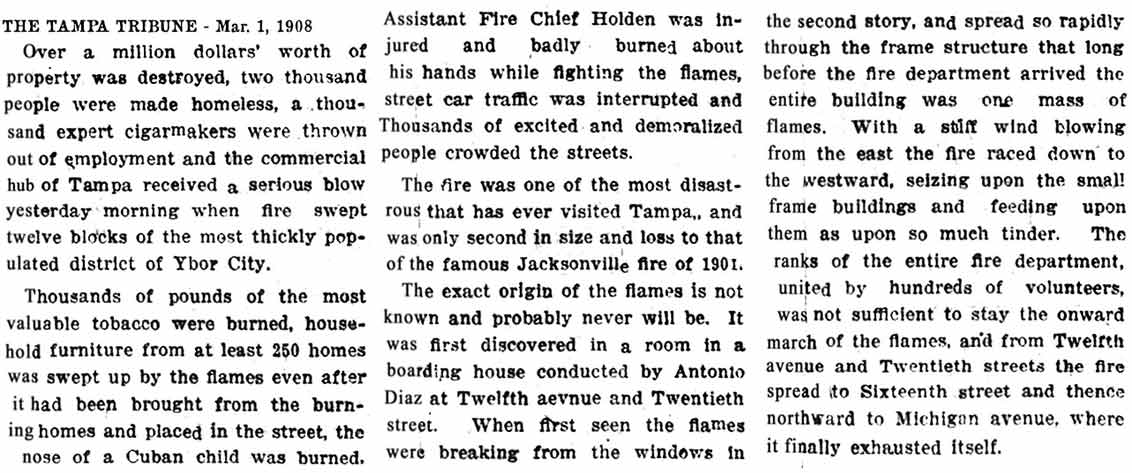
This is a short portion of the front page article. Click
it to read the whole article, it is long. When it opens, click
it again to see it full size.
NOT
"LA TROCHA"
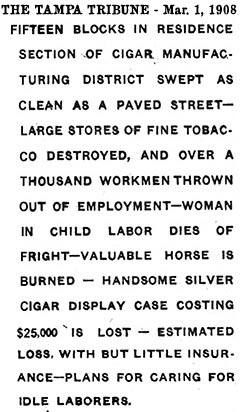 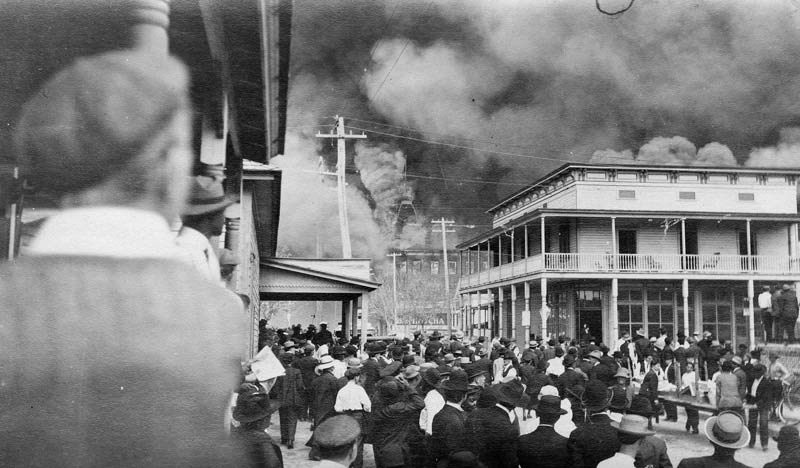
Photos above and below are courtesy of the University of Fla. George A. Smathers
Library digital collection, from the Pizzo collection.
Described as: A Crowd watches La Trocha Cigar
Factory engulfed in flames during the Ybor City Fire of 1908 from
12th Avenue and 17th Street North.
There was no such factory or company as "La Trocha."
This was the Stachelberg cigar factory and the "La Trocha" sign seen
below it marks a building immediately before it which was a restaurant,
not a cigar factory.
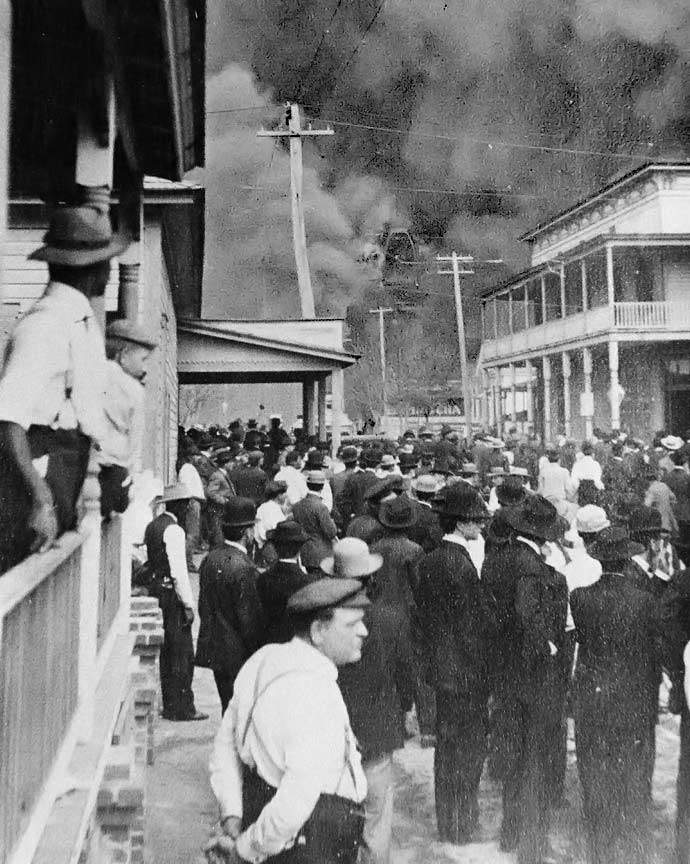
The above photo also has a general note: "The scene was taken from 12th Avenue and 17th Street looking
North.
In the center appears the La Trocha Cigar Factory with it's clock
tower being consumed by flames."
(Not La Trocha cigar factory. The writer was mislead by the signage.)
|
BLAME THE SIGN?
Closer inspection of
the photos show a tower of a cigar factory with a building and a
sign "La Trocha" blocking the view of the factory so that only the
factory's upper stories and clock tower are visible above it. Below,
the caption comes from the Pizzo collection of photos at
UF. |
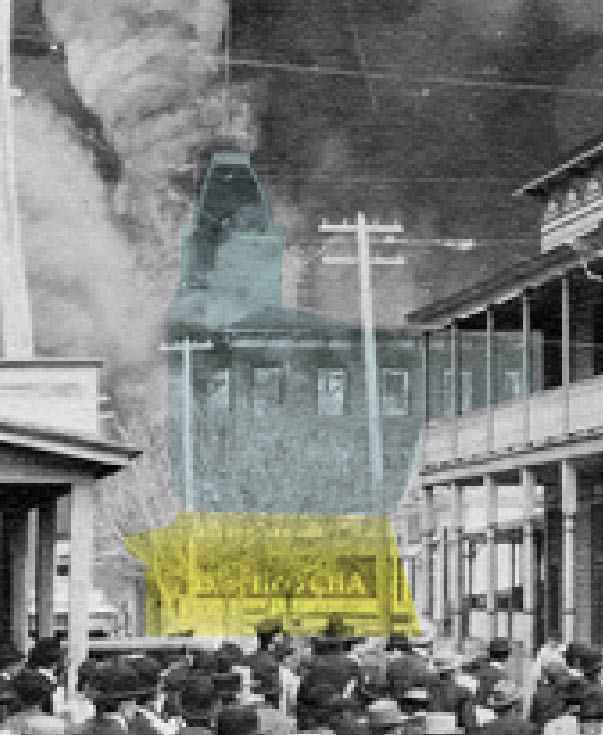 |
|
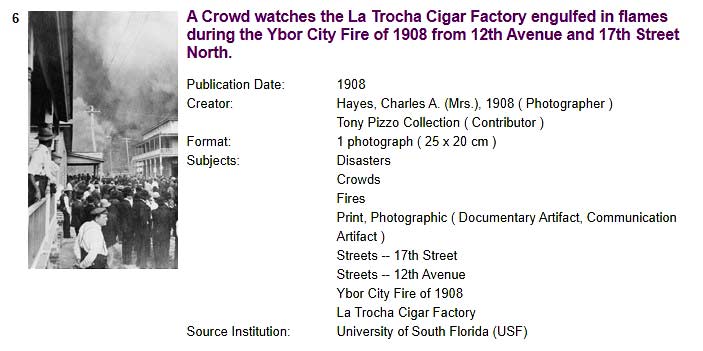 |
|
EVIDENCE
The 1903 map below is oriented with
north to the left. The above fire photos are said to be taken from 17th St.
and 12th Avenue looking north. That area is marked with a red
rectangle below. The red dashed line is the approximate
centerline of the photo and the pink shading is the approximate
angle of view. In 1903 there were several vacant properties
and some properties with dwellings in the area. At some time between the
making of the 1903 map and the March 1, 1908 fire, there were many
new structures built, probably where the green rectangles are shown,
judging by the foreground buildings in the photos.
Notice that across the street at
extreme right of the first photo (wide view) can be seen what
appears to be a park or plaza. The St. Joseph's convent
property would have been situated there. The "La Trocha" sign
in the photos would have been situated where seen below in green and
would have been built between 1903 and the fire in 1908.
The factory in view
is actually the Stachelberg cigar factory.
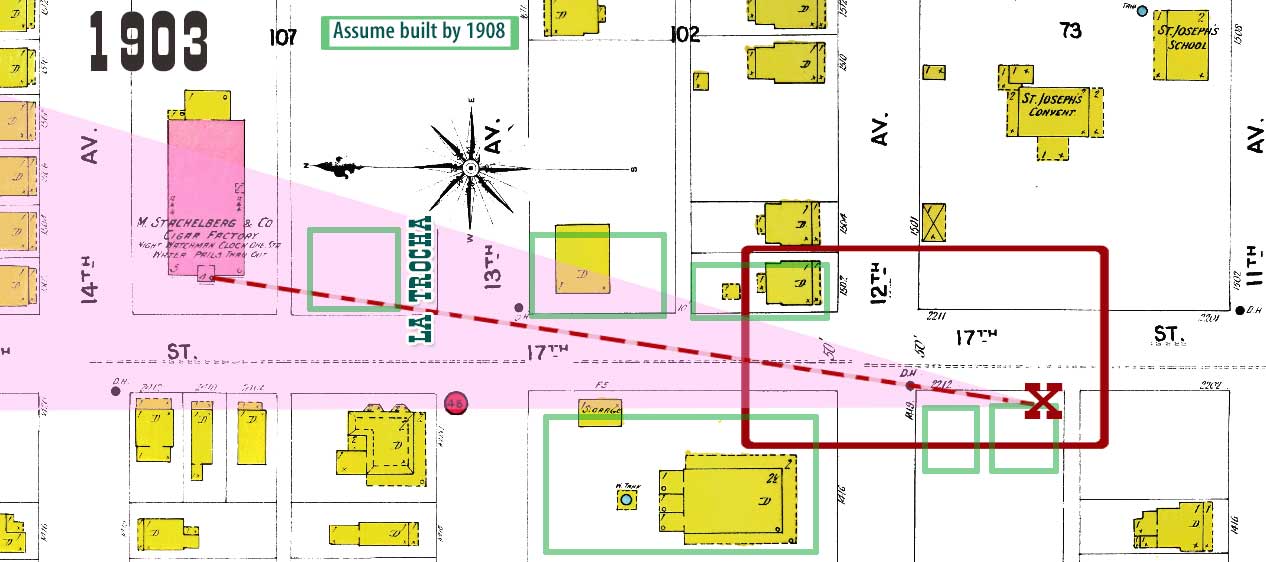 |
THE STACHELBERG CIGAR FACTORY
AND LA TROCHA RESTAURANT
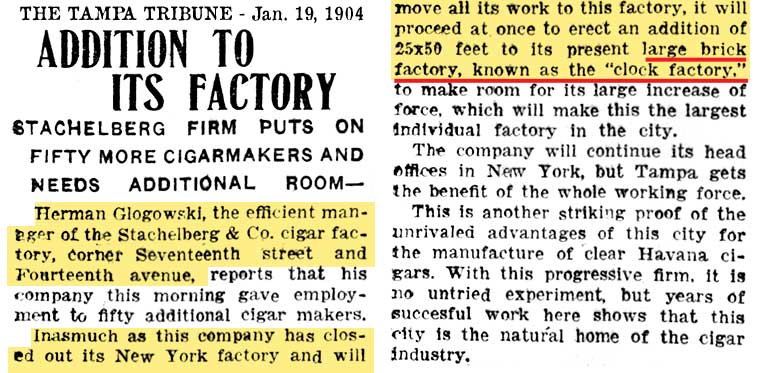 There
are plenty of mentions of the Stachelberg cigar company and
factory in the Tampa Tribune for this period. The Tribune carried ads for their cigars.
According to his 1904 Tribune article, it was managed by former Tampa
Mayor Herman Glogowski when they moved their entire operations to
Tampa from New York, to their "present large brick factory, known as
the 'clock factory.'" There
are plenty of mentions of the Stachelberg cigar company and
factory in the Tampa Tribune for this period. The Tribune carried ads for their cigars.
According to his 1904 Tribune article, it was managed by former Tampa
Mayor Herman Glogowski when they moved their entire operations to
Tampa from New York, to their "present large brick factory, known as
the 'clock factory.'"
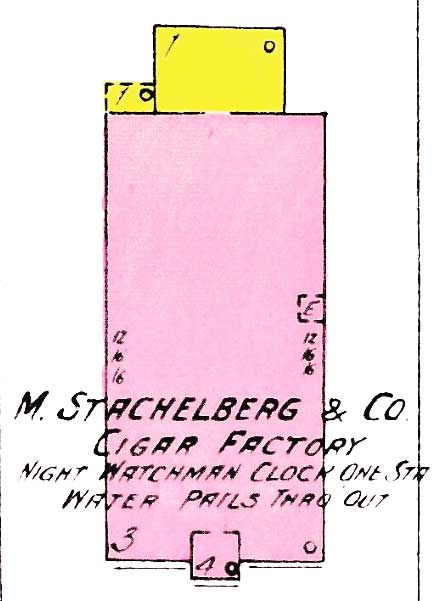
Notice the factory was 3 stories with
a 4-story tower at front center. Their fire fighting equipment
consisted of buckets of water throughout the factory.
The only mention of La Trocha that
could be found at any time in Tampa's newspapers was a
mention in a damage assessment of the fire, and it is a restaurant.
"LA TROCHA"
MENTIONED IN FIRE LOSS ASSESSMENT
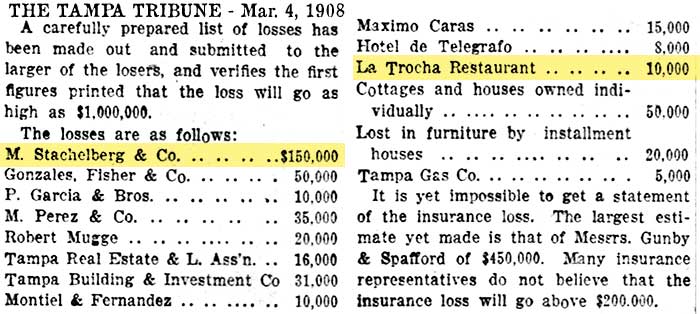
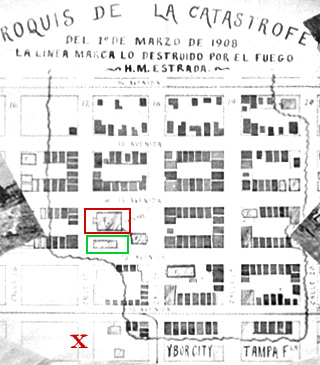
At Left: Part of the PIzzo
collection at UF is a photo of this map of 1908 showing
the area of fire destruction. The Stachelberg Cigar
factory is shown in the red rectangle. Here, a
structure can bee seen just south of the factory, marked here in green.
This is the location where the building obstructing the view of the
factory, and showing the sign "La Trocha," would have been so it
would appear as it did in the fire photos. The X marks the
approximate location from where the photos were taken. The 1908 map was created to show the
fire damaged area, so not much else was drawn outside of it.
Notice the area is more developed in
1908 than it was on the 1903 map shown below.
LA TROCHA RESTAURANT
BUILT IN 1905 BY ROBERT MUGGE
Although not specifically mentioned as being named "La Trocha,"
these articles indicate that it was a brick building built in 1905 by Tampa
liquor dealer and hotel/saloon/bowling alley owner Robert Mugge. The
building is described as being on the same block as the Stachelberg
factory. ("La Trocha" is Spanish for a line of fortifications,
usually rough, constructed to prevent the passage of an enemy across
a region. It can also mean a shortcut, path or trail.)
The 1905 construction year fits in with it not being on the 1903
map, but appearing on the H. M. Estrada fire damage map above for
1908.
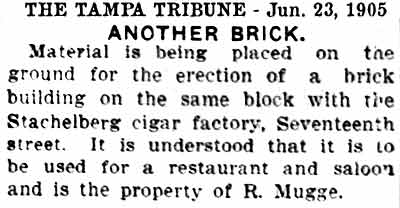
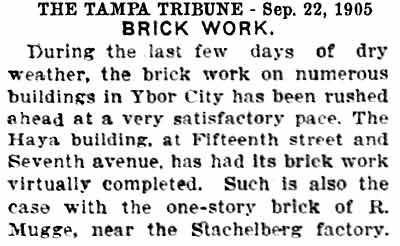
Below is a 1903 Sanborn map of Ybor
City. La Trocha Restaurant has been added where a building
was indicated on the above Estrada map. The X marks the approximate
location where the Pizzo collection photo was taken from. The
fire damaged area is enclosed by the orange dashed line.
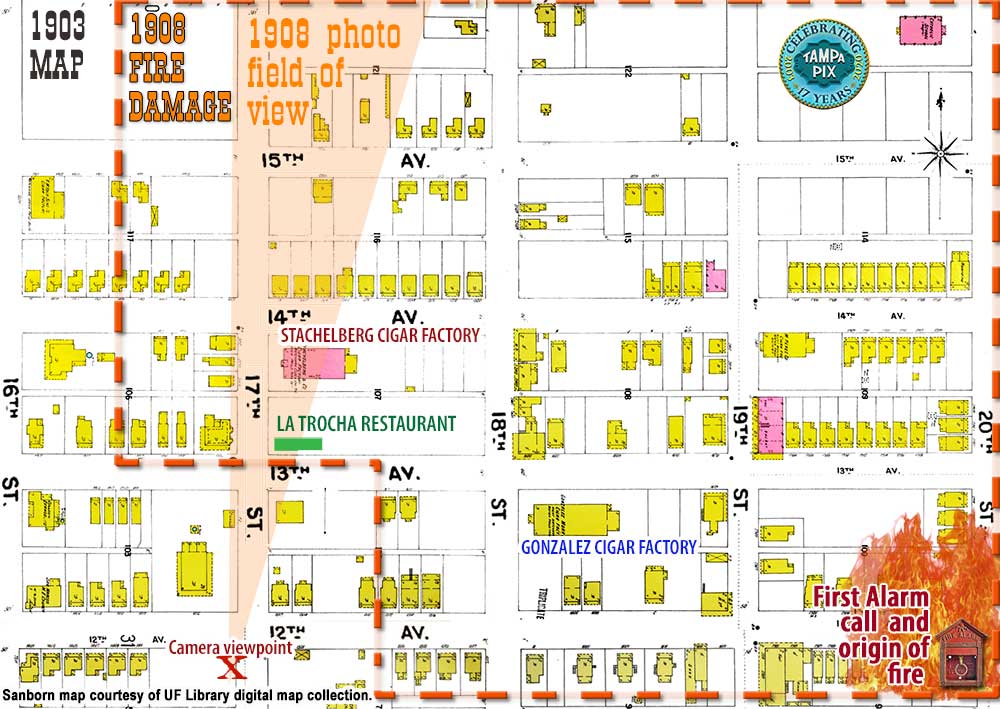
Photo below courtesy of the University of Fla. George A. Smathers
Library digital collection, from the Pizzo collection.
Described as: A Horse-drawn fire engine roars to the
scene of one of the many breakouts during the Ybor City Fire of
1908.
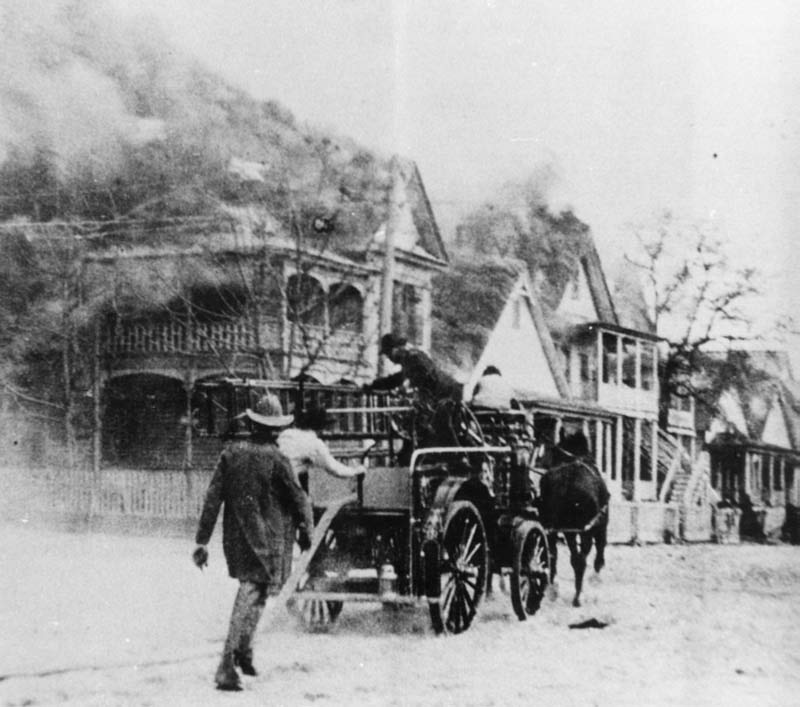
Photo below courtesy of the University of Fla. George A. Smathers
Library digital collection, from the Pizzo collection.
Described as: People view the Ybor City Fire from a
distance.
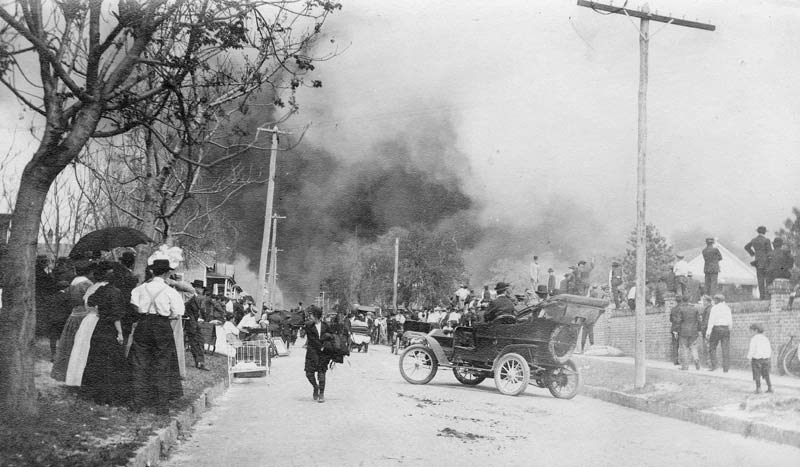
Photo below courtesy of the University of Fla. George A. Smathers
Library digital collection, from the Pizzo collection.
Described as: People look from the railroad track
near the Florida Brewing Company and the Ybor City Ice Works at the
Ybor Fire of 1908
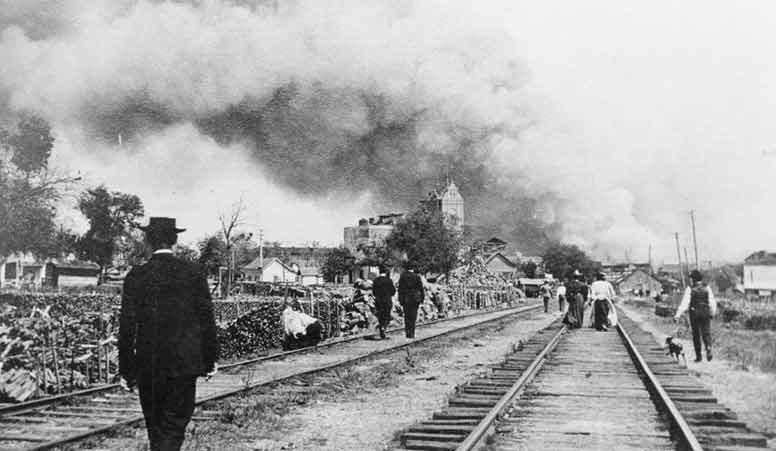
The tall building is the brewery, the building to the left of it is
the Ybor Ice Works.
Photo below courtesy of the University of Fla. George A. Smathers
Library digital collection, from the Pizzo collection.
Described as: People stand along a protective brick
wall looking at the Ybor City Fire of 1908.
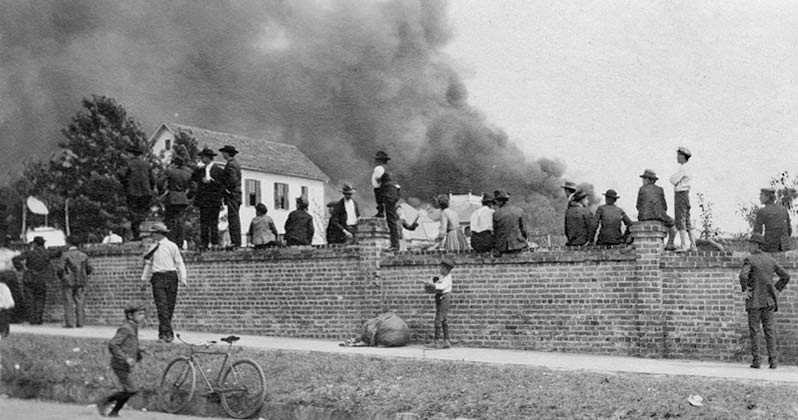
Photo below courtesy of the University of Fla. George A. Smathers
Library digital collection, from the Pizzo collection.
Described as: Fire consumes a wooden structure just
feet from the brick Pierce Building.
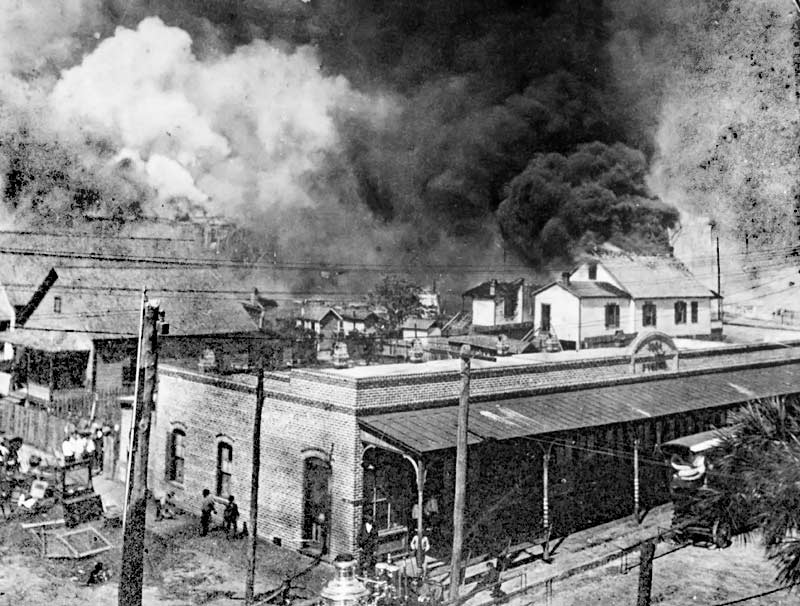
Notice the steam-powered pumper fire truck at center foreground.
It was probably the "Elmore Webb."
The above photo has a general note:
A massive fire in 1908 was "the worst of the worst,'' Ybor City took
the blow with 18 blocks leveled on Sunday, March 1. Losses
exceeded $1 million, and 171 homes burned, along with 42 business
buildings and five cigar factories. Half of the losses were covered
by insurance. When neighbors saw the fire approaching, they piled
their furniture and possessions into the streets, hoping to save
them. "But the flames jumped from the houses to the furniture, and
with a hefty wind it spread the fire that much more,'' Firefighters
were hampered by low water pressure from Tampa Waterworks. The
problem became an issue in the aftermath, with critics questioning
whether the private utility favored its other customers at the
expense of Ybor City.
| |
THE
ELMORE WEBB STEAM POWERED PUMP FIRE TRUCK |
|
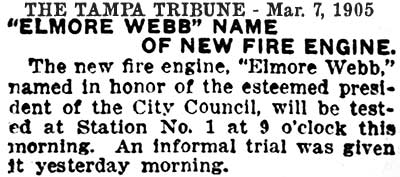
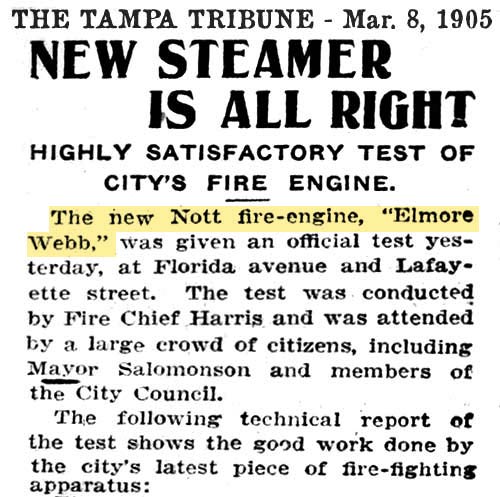 |
This
photo is from the Burgert Bros. collection at the
Hillsborough County Public Library System, but the
Burgert catalog describes it as La France
horse drawn steam piston pumper, named Elmer [sic] Webb,
assigned to Station 4 of the Tampa Fire Department.
But articles from the time it was purchased, tested, and went into service show it was
a Nott engine, not a La France, and it was first assigned to
Station No. 1.
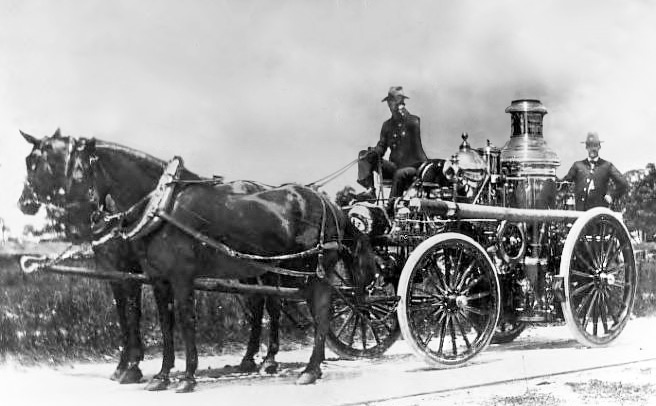
Click the article on the
left to see the full test results. |
|
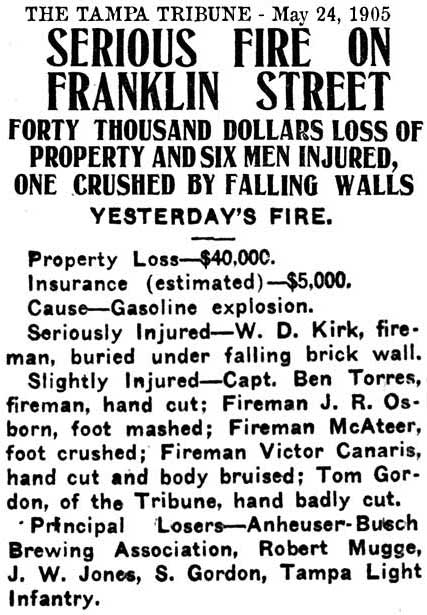 |
A very dangerous fire
occurred on Franklin St. on May 23, 1905 which involved
the Tampa Light Infantry Armory building, owned by the
Anheuser Busch Brewing Assoc., Robert Mugge's Armory
Saloon, the Gordon pawn shop, and the J. W. Jones "Bee
Hive" store at Franklin & Cass St. Thousands of
rounds of ammunition fired off in the blaze, a wall and
ceiling collapsed, and a handful of fireman were
injured. Several firemen are named in this
article, as well as the Elmore Webb fire engine on the
scene. The fire started in the Bee Hive store when
the chief clerk struck a match to light a gasoline lamp.
Click
the article at left to read it in its entirety.
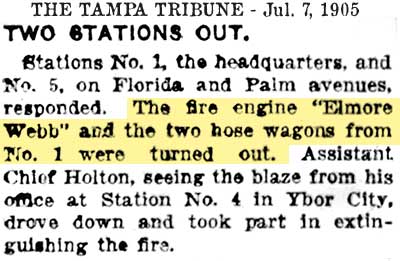 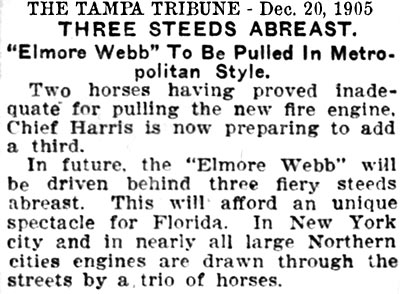
In late
Dec. 1905, it was decided that THREE horses would pull
the Elmore Webb, as two were found to be inadequate.
|
THE "MAJOR WRIGHT"
STEAM POWERED PUMP TRUCK
In Jan. 1908, a new fire
engine was purchased from the Nott company; it was the
largest yet made by Nott. Once it was assembled
and ready to use at Station No. 1, the
Elmore Webb was given a complete overhaul and was then
sent to Station 2 in Ybor City--not a moment too soon.
No "official christening" took place for the
new truck. A ceremony
was to be held at the state fair but the city council
and Mayor Frecker were to have other matters to take
care of that day and it was feared that the new engine
"would prove but a minor attraction compared with the
wonders contained in the acres comprising the state fair
grounds."
|
|
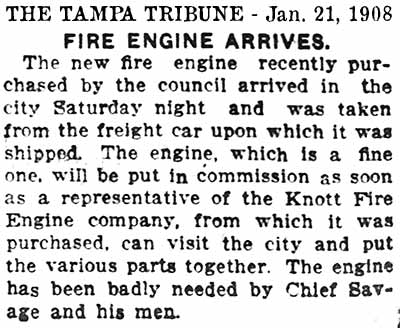
Below: TFD took delivery of a custom-built truck
designed by Chief Tucker Savage. It was for use at
the Hyde Park station.
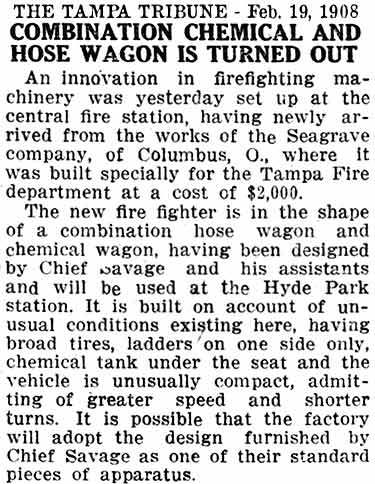
AT
RIGHT:
The Nott
Co. steam pumper "Major Wright" in front of Station No.
1 circa 1908-1911. |
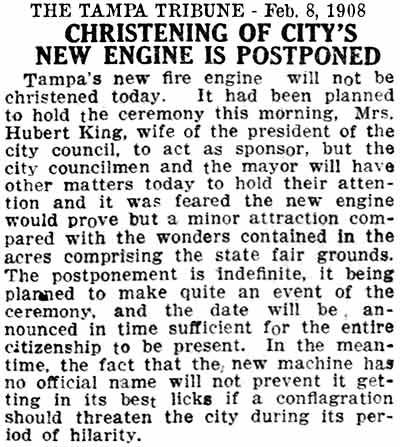
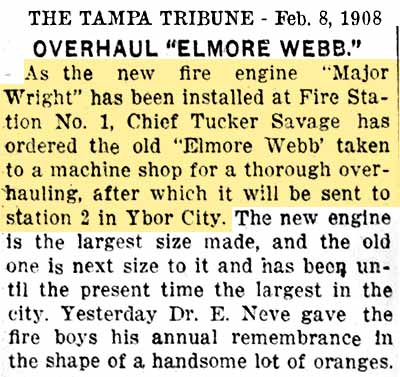 |
|
Photo courtesy of
Capt. Bill
Townsend's "Tampa's Bravest" website.
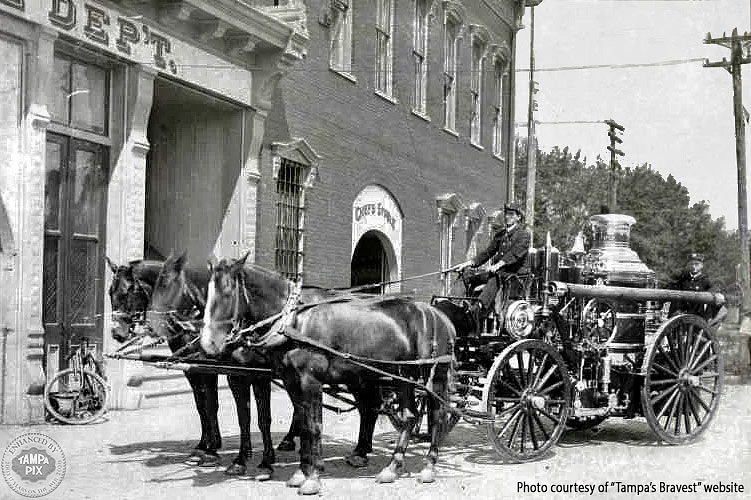
Notice
three horses were needed to pull this truck, being even heavier and larger than
the "Elmore Webb." |
THE DAMAGE, IMPACT
AND RELIEF EFFORTS
Tampans rose quickly
to the crisis by meeting on the afternoon of March 2 at the Spanish
Casino in Ybor to form a central relief committee. Their goal
was to devise a plan so that funds and supplies could be quickly and
fairly distributed. A relief committee, an investigating
committee (to assess and verify the need) and officers were named.

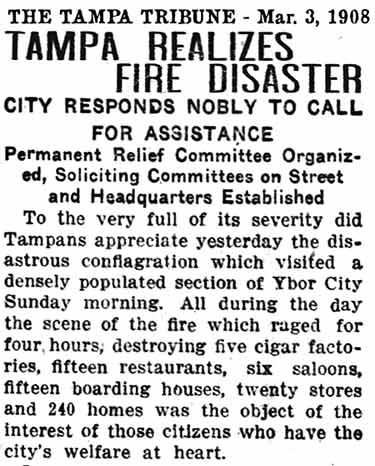 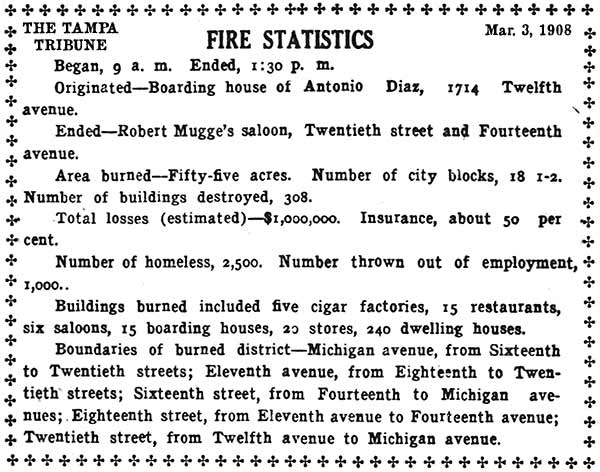 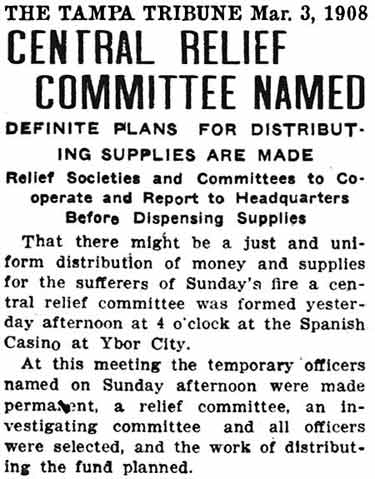
Click the articles on
the left and right to read them in their entirety.

In 2021 dollars the rate of
destruction was about $933/sec.
Photo below courtesy of the University of Fla. George A. Smathers
Library digital collection, from the Pizzo collection.
Described as: A View looking on 19th Street looking
west on 12th Avenue after the Ybor City Fire of 1908.
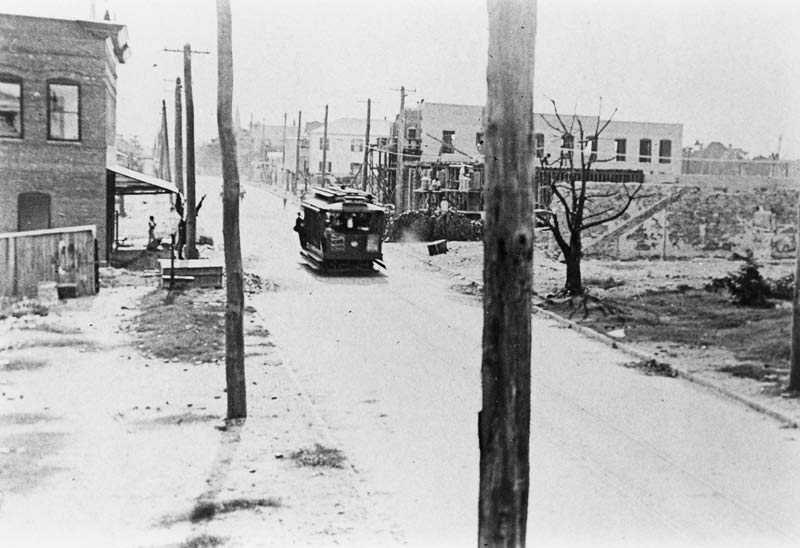
RELIEF COMMITTEES
TAKE ACTION
The Chamber of Commerce
met to take steps to raise funds for the relief of the fire vicitims,
and the committee formed by Tampa businessmen quickly received
$3,000 in donations by March 3.
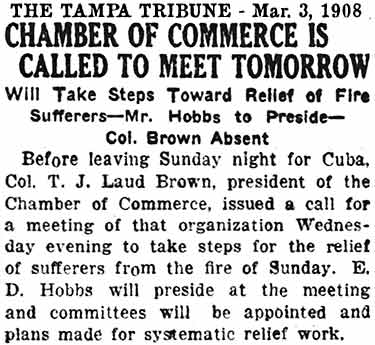
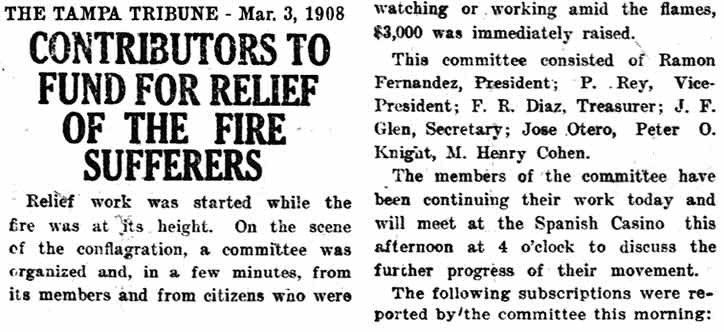
Click the article on the right to see the list of
contributors and amounts.
Photo below courtesy of the University of Fla. George A. Smathers
Library digital collection, from the Pizzo collection.
Described as: The Aftermath of the Ybor City Fire of
1908.
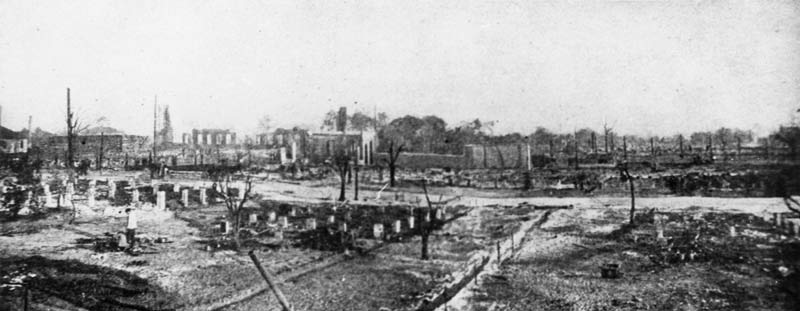
The above photo has a general note:
"A $600,000 conflagration at Tampa, Fla.. General view of the burned
section, fifty five acres...
in area were destroyed and hundreds of persons were made homeless"
- C.E. Lambright, Florida.
Photo below courtesy of the University of Fla. George A. Smathers
Library digital collection, from the Pizzo collection.
Described as: The Aftermath of the Ybor City Fire of
1908.

The above photo has a general note:
The great fire of 1908, which leveled 18 city blocks, destroyed
dozens of factories, shops and homes, and led to an overhaul of
the city's firefighting systems. (There was inadequate
water pressure to put out the blaze early). Frightened residents
huddled in the street next to piles of their possessions,
firefighters dynamiting buildings in an (unsuccessful) attempt
to stop the spread of the fire and a horse, engulfed in flames,
escaped from its stall and running down the street shrieking in
pain.
Photo below courtesy of the University of Fla. George A. Smathers
Library digital collection, from the Pizzo collection.
Described as: The Aftermath of the Ybor City Fire of
1908.
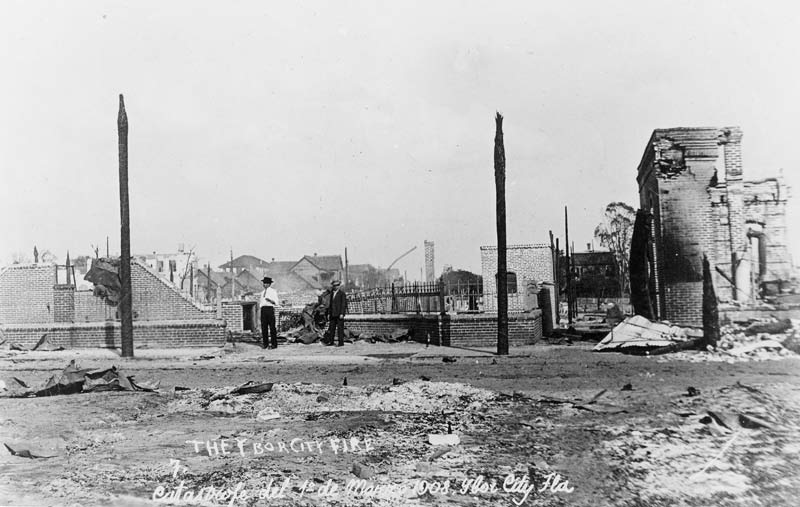
|
MAN SENT INTO THE BURNING
FACTORY TO RESCUE BOOKS
A cigar maker, Arthur Brooks, at the
Stachelberg factory was sent back into the burning
building to retrieve "certain books which the management
greatly desired." On his way back out, he was
blocked by a "solid sheet of flame." As he was
looking for a way of escape, he heard a man calling for
someone to save him. Brooks called back that he
himself could not find a way out and then jumped out a
window from the 2nd story. Brooks was seriously
injured, and immediately afterward the factory walls
collapsed. It was thought that the man calling for
help was burned to death but a through search afterward
resulted in no one reported missing. |
|
MAYOR
FRECKER TO FILE LAWSUIT AGAINST THE WATERWORKS CO.
Mayor Frecker agreed
with the fire department, stating that the water
pressure was below what was needed and below what was
supposed to be supplied by the waterworks company.
The superintendent of the waterworks disagreed, stating
that no waterworks system could have supplied sufficient
water pressure when the demand reached as high as it did
at this fire, and that everything possible was done to
provide as much water and physically possible to Ybor
City. |
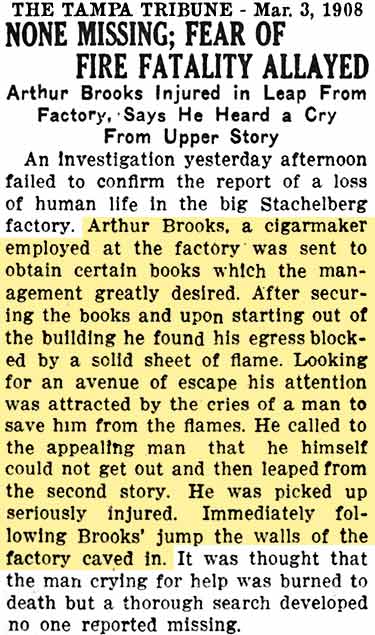 |
|
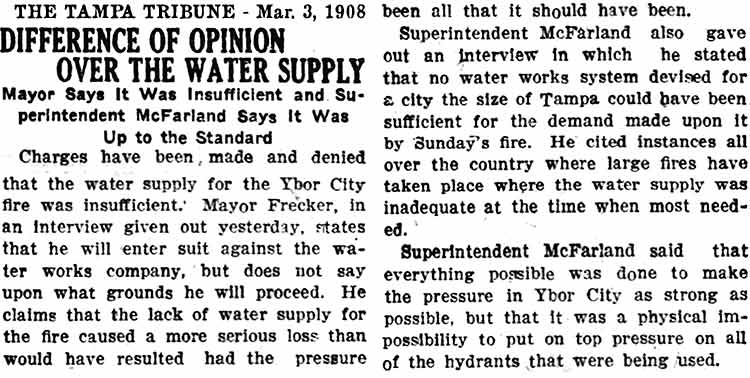 |
Described as: People evaluate the aftermath of the
Ybor City Fire of 1908.
This is the ruins of
the Stachelberg Cigar factory, with the site of
La Trocha Restaurant
to the right of it, behind the people.
Photo below courtesy of the University of Fla. George A. Smathers
Library digital collection, from the Pizzo collection.
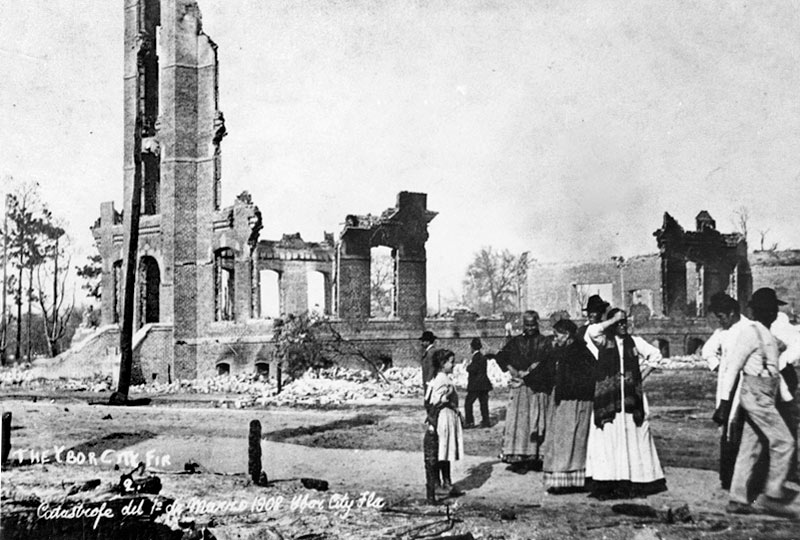
|
THE GOOD, THE BAD, AND THE UGLY
The people of Tampa, its clubs, and organizations all rose to the occasion to help the
victims of the fire. Not all victims were people who lived in
Ybor City who lost their homes, many were factory workers,
restaurant workers, and employees of the many business who lost
their jobs because of the fire's destruction, but lived outside of
Ybor City.
|
|
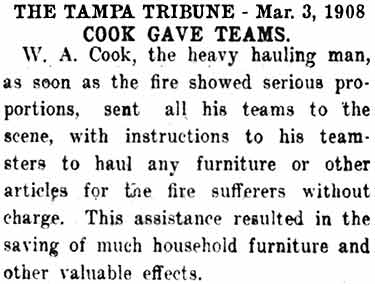
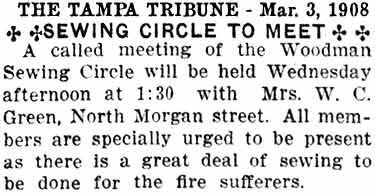
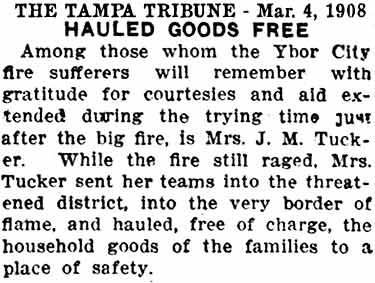 |
|
JUDGE
AND WIFE SKIP TRIP TO HAVANA
Judge Evans and his wife
decided to skip their trip to Havana and donate the
funds they would have spent to the fire sufferers.
Businesses were donating a percentage of proceeds,
Hillsborough County donated $500 to the relief fund,
matching that of the City of Tampa's donation. The
first of the fire victims received $3 worth of groceries
based on the size of his family. All these may not
seem like much to us, but $500, 5 cents, and $3 in 1908
is like $14,143, $1.41, and $85 today in 2021. The
relief fund wasn't just for those who lost property in
the fire, it was also for those who had lost employment
due to the fire. The Mar. 4 article say 250 people
had received enough food to last them a week. |
|
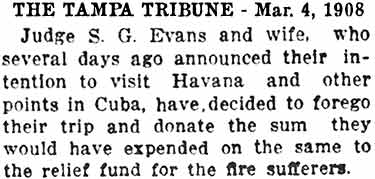 |
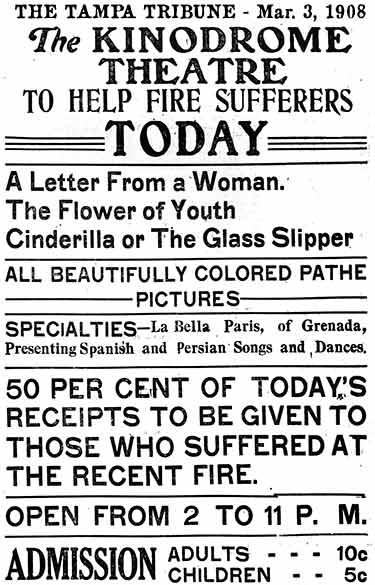 |
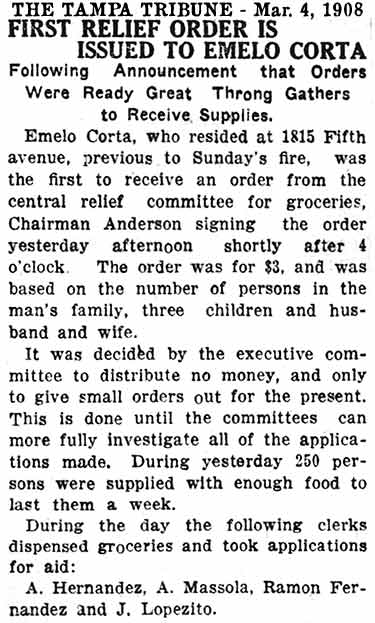 |
|
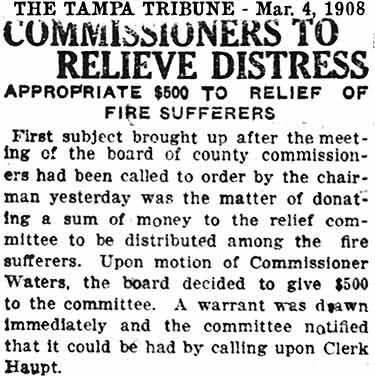 |
CITY OF
PENSACOLA GATHERING CONTRIBUTIONS TO HELP YBOR'S FIRE VICTIMS

|
LOOTING AND CRUEL TAUNTING
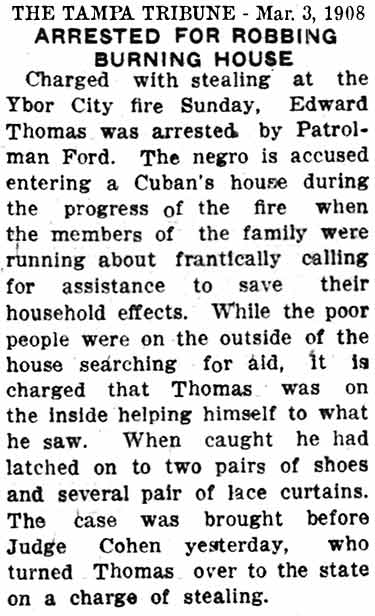 |
The
fire and also brought out the bad and ugliness in
some people--looting, burglary, taunting, price
gouging, and opportunism.
A man was arrested for
robbing a house while the family was out in the
street trying to get help in hauling their household
effects to safety.
Young men in a car
at 7th Ave. and 16th St. nearly cause a riot when
they laughed and made disparaging remarks at the
pitiful plight of an old woman who had saved nothing
but two pillows from the fire; her home was
destroyed. The article says they all seemed to
be "more or less under the influence of liquor."
Some cigar makers in the area resented the remarks
and "in a few moments considerable excitement
prevailed." The driver had
"sufficient presence of mind to move on...out of
reach of the angry Cubans." |
|
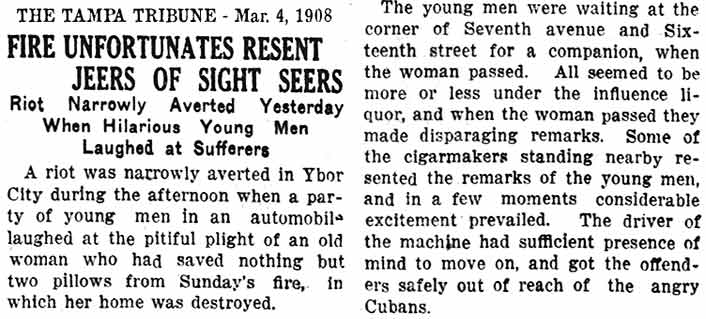 |
|
OPPORTUNISM AND PRICE GOUGING
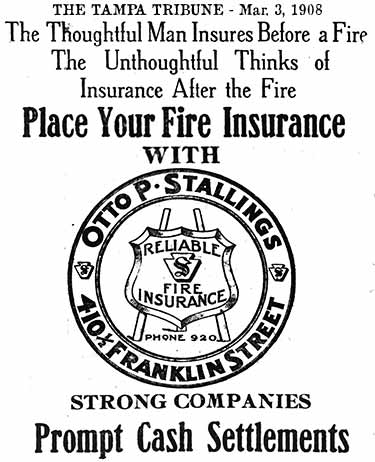 |
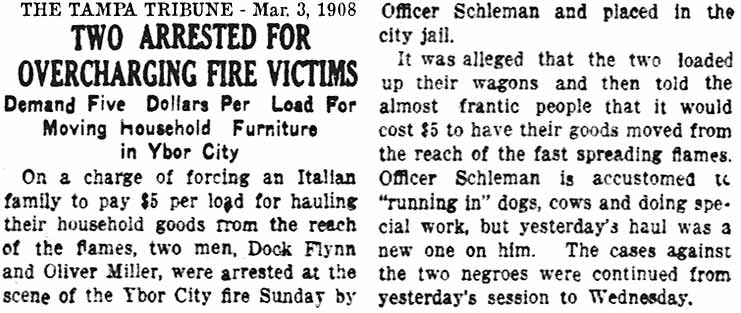
Jacobs
placed his ad multiple times on a page, on multiple
pages. After just about every article of the
fire there was a Jacobs ad. As for the photos,
it's possible some of these are in this feature.
 |
|
TREMENDOUS EFFORT AND
TEMPORARY FACTORY QUARTERS SPEED REEMPLOYMENT, DAMAGE
REASSESSED
Just
three days after the disastrous fire, over half of
the cigar makers who lost their jobs were expected
to be back at work, and by the end of thhe next
week, it was expected that even more would be
working then were before the fire. Stachelberg
took up temporary quarters in the factory formerly
occupied by Ramon Fernandez and was expected to
resume operations this day.
Edgar
Stachelberg claimed that plans were already in the
making to rebuild the factory on the same site and
that it would be the finest cigar factory in the
world.
Factory
managers claim they did not overestimate the losses
by the factories, it was expected to top $1 million,
but there was considerably more insurance on them
than first thought. Many insurance reps
believed the total insurance losses would not go over
$200k, but Gunby & Spafford estimated $450k. |
|
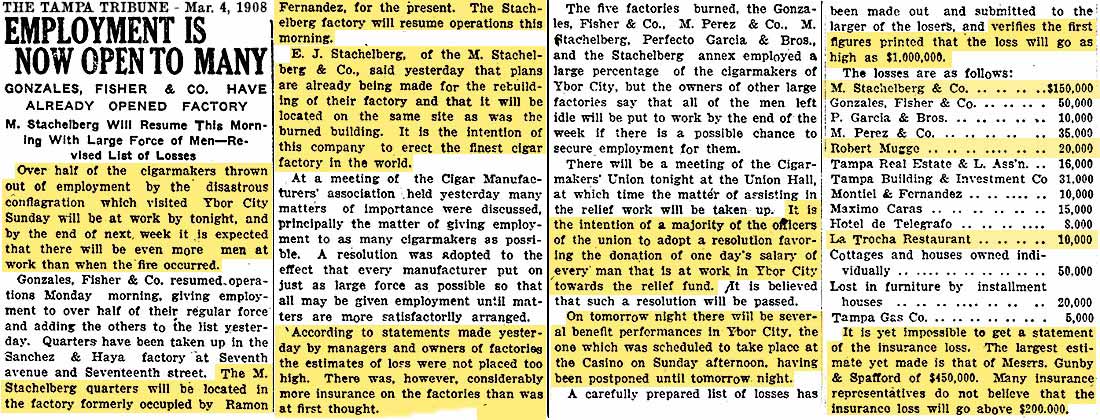
Apparently, Stachelberg changed his mind about
rebuilding on the same site, or maybe even
rebuilding at all in Tampa or Ybor City. The
1915 Sanborn map of 14th Avenue & 17th Street shows
a wood frame "El Canatabrico Hotel" was built on the
factory site, nothing on the La Trocha Restaurant
site, and a large Sanchez & Haya factory on the west
side of 17th Street. However, the former
Stachelberg block was then called the "Stachelberg
subdivision."
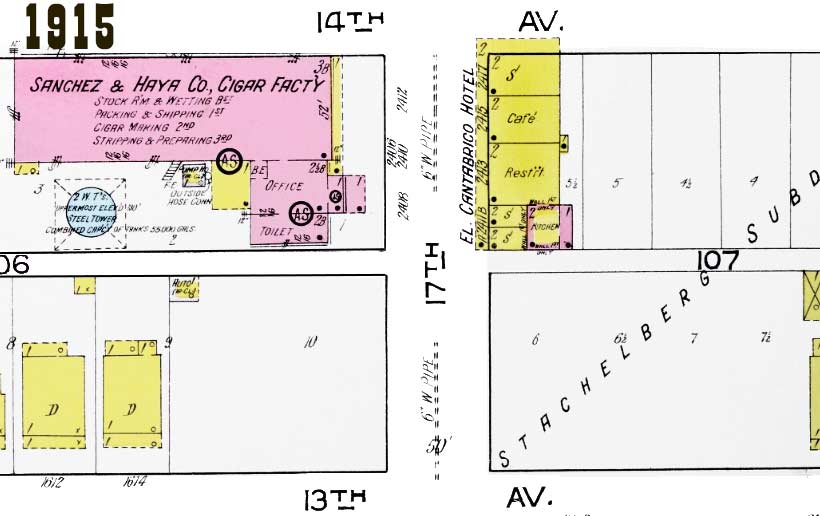 |
|
|
ARSON IN WEST TAMPA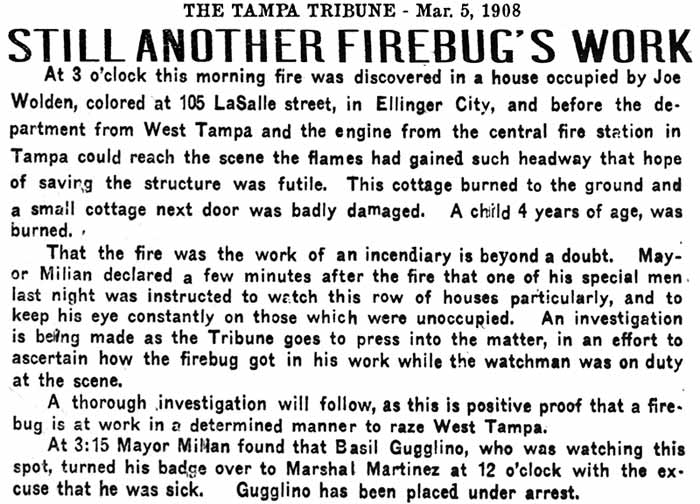
The Ybor City fire caused a wave of suspicion and
near paranoia in West Tampa as citizens began to
look at every fire to be of "incendiary" origin
(arson.)
West Tampa Mayor
Francisco Milan was on heightened alert, even
patrolling the streets himself.
At right, a man whose
responsibility was to keep an eye on an area on
LaSalle street, was suspected of being involved with
an arson there in which "a child was burned."
Basil Guggino claimed he was sick when he turned
over his badge to someone else and went home.
He was arrested, as this was "positive proof that a
firebug is at work in a determined manner to raze
West Tampa."
Below, on the morning
of March 3, Mayor Milan found kerosene soaked rags
on fire in his chicken coop, and several chickens
missing.
A Cuban woman called
on a property owner in order to rent one of his
houses because she was told that the district in
which her home was located was about to be burned.
A fire at the
Seidenberg factory was determined to be arson after
first being attributed to faulty wiring. After
inspection of the wiring, it was discovered that
there were no wires within twelve feet of where the
fire started.
|
|
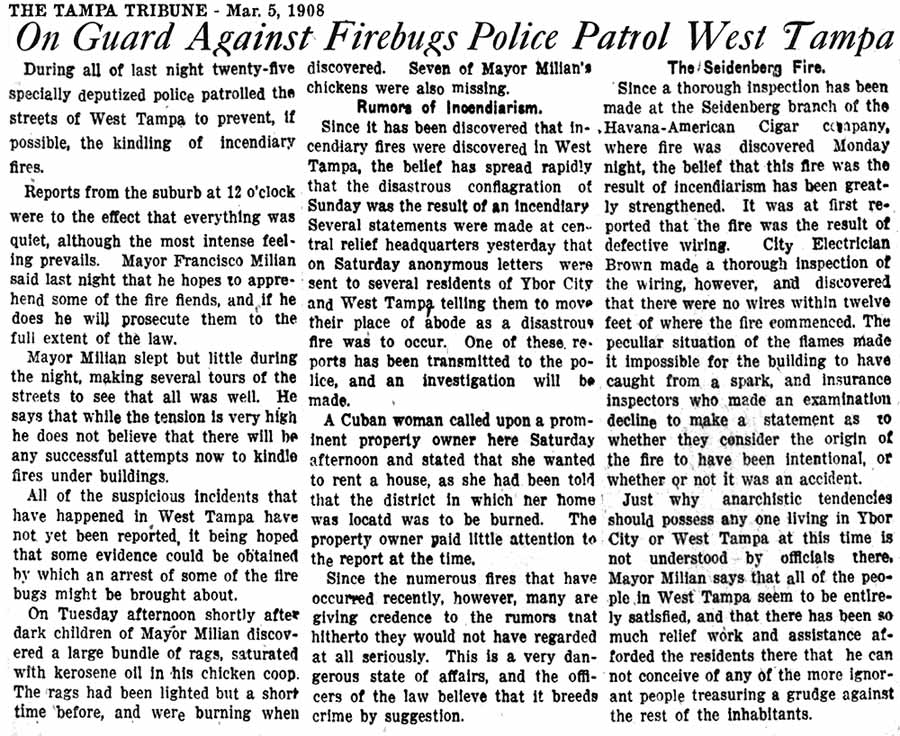
A record-setting seven
fires in five days started the month of March, 1908
in Tampa. Although the above article didn't
reveal it, the one below says a woman and her two
children were casualties of the fire on LaSalle
Street. The cause of two fires below were
described and not due to arson.
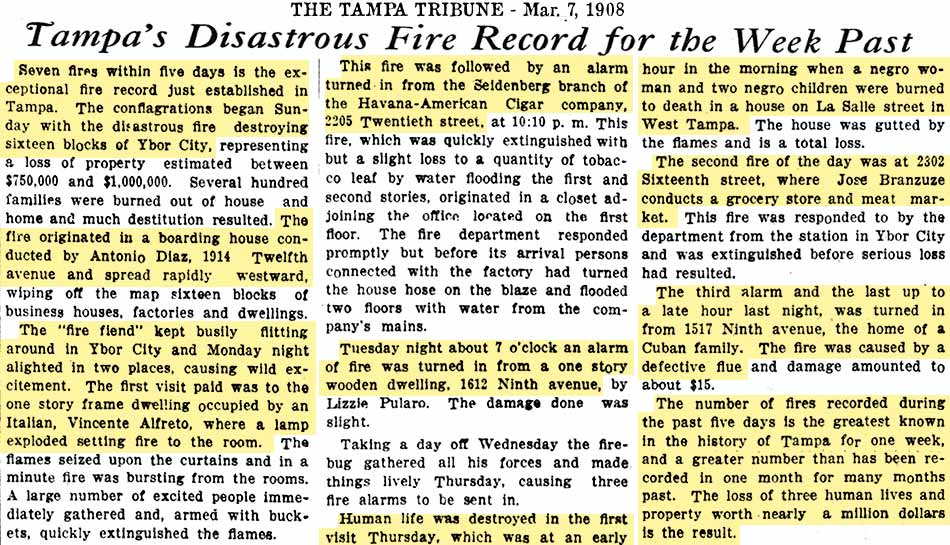
CITY
TO CANCEL CONTRACT WITH WATERWORKS BASED ON BREACH
OF CONTRACT
On Mr.
5, 1908, the City Council was to meet to discuss the
annulment of their contract with the waterworks
company based on the company's failure to carry out
its guarantee of minimum water pressure under any
circumstances. Stewart Wood, the treasurer of
the waterworks, stated that many obstacles,
including recent litigation, had impeded its
progress but that many improvements had been made in
the previous years despite lack of sufficient
revenue. He also stated that the stockholders
of the company for many years had not realized one
penny of dividends from their stock because of this.
The article describes in detail the specific
improvements they made and that all income, except
$6,000 a year in interest, had been expended in
making improvements. It was the general
opinion on the street that the waterworks had
succeeded in upholding their responsibilities, and
that it was going to be difficult for the City to
show otherwise. It was believed that the
company had a solid defense as it did when
litigation was brought against it to reduce its
rates--the company has never realized a profit.
The article below has been shortened, with the list
of improvements removed. Click it to see the
full article.
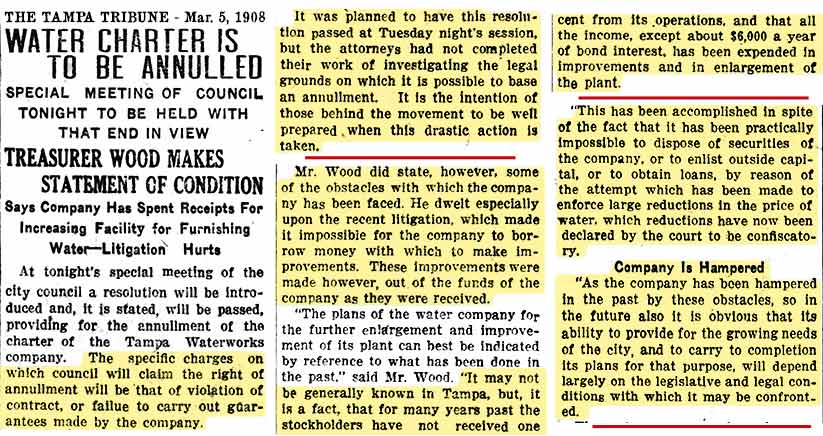
Eventually, the City
went to the State Supreme Court with the waterworks
matter, and the case still had not yet been decided
by the time of the June 1908 elections in Tampa.
The issue with the waterworks was big ammunition for
Frank Wing, with M. B. Macfarlane calling Frecker
a liar and an anarchist. It was an
election that Mayor Frecker lost to Frank Wing.
BELOW:
Excerpts from Frank Wing's first campaign rally.
M. B. Macfarlane was Matthew Biggar Macfarlane.
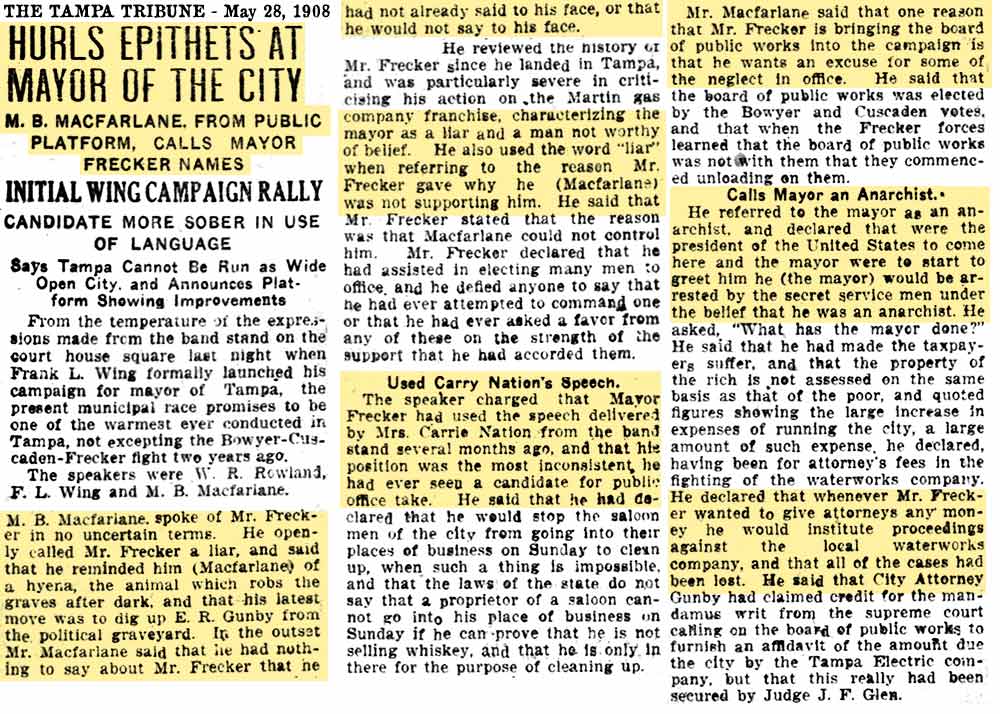
FLORIDA SUPREME COURT RULES FOR TAMPA WATERWORKS
COMPANY
On July
7, 1908, the Florida Supreme Court denied Tampa's
petition and ruled that the waterworks company did
not breach is contract in regard to supplying
sufficient water pressure. The decision came
as no surprise, as the waterworks had done all they
possibly could to maintain and improve the system
over the years. The decision also affected any
private lawsuits in the Circuit Court against the
waterworks for damages caused by the fire. The
City Attorney recommended the withdrawal of the suit
and so the issue came to an end.
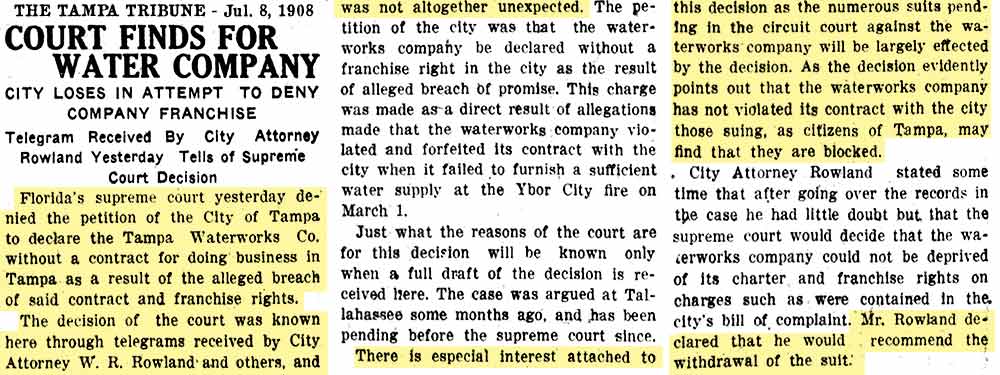
|
STACHELBERG HISTORY
WHEN WAS THIS YBOR CITY FACTORY BUILT?
and
COULD ITS CLOCK HAVE BEEN THE OLD TOWN CLOCK FROM THE COUNTY
COURTHOUSE?
Photo below courtesy of the University of Fla. George A. Smathers
Library digital collection, from the Pizzo collection.
Described as: The La Trocha Cigar Factory, once at
17th Street and 13th Avenue, destroyed in the 1908 fire.
This is actually the Stachelberg Cigar
factory. There was no "La Trocha" cigar factory or company.
This photo has been digitally restored and enhanced.
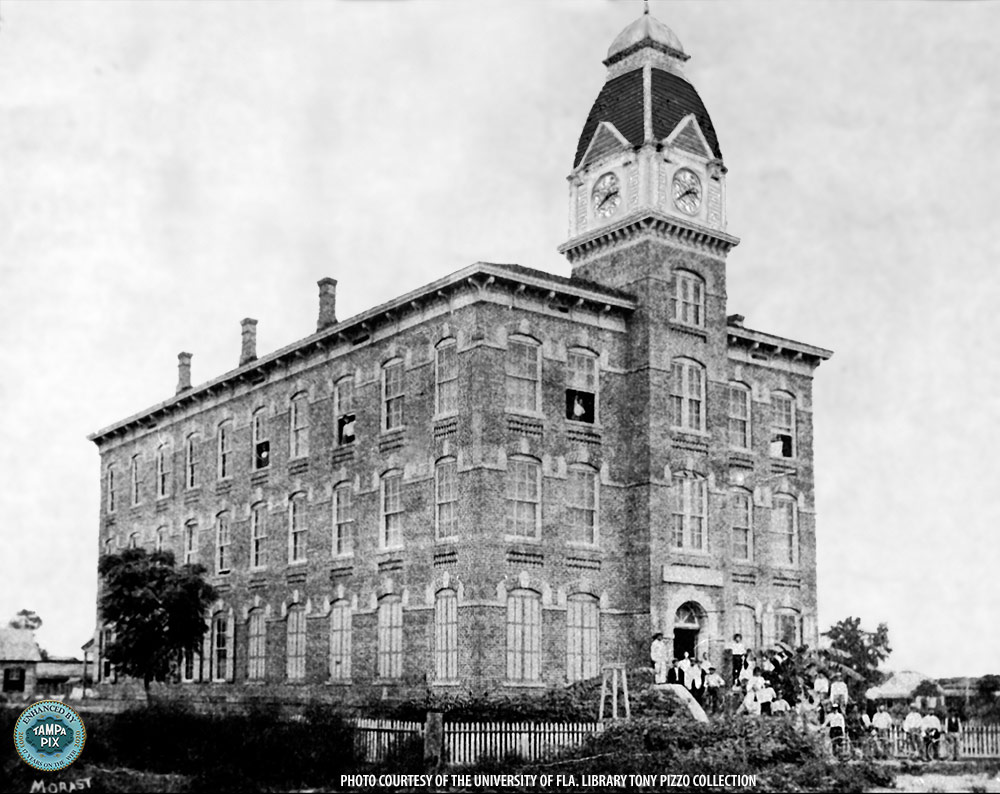
In 1902 Tampa
businessmen bent over backwards to get Stachelberg to build a cigar
factory on the east end of Lafayette Street between Brush and
Governor Streets. A. H. West donated six lots, which was all
of block 21, to meet part of Stachelberg's demands,
in order to entice them into building a
$20,000 factory which would employ 600 workers. But Edgar Stachelberg
also wanted the people of Tampa to buy $10,000 of their stock.
The donated land was worth $3,000 and each lot was 70 feet of
frontage. A committee consisting of Tampa businessmen met on
Mar. 19 to discuss the terms. Other plans to entice
Stachelberg were discussed, such as building a street railway line
down Lafayette St. past the factory and across the Ft. Brooke
property into East Tampa. ($3,000 in 1908 is like $84,857 in
2021.)
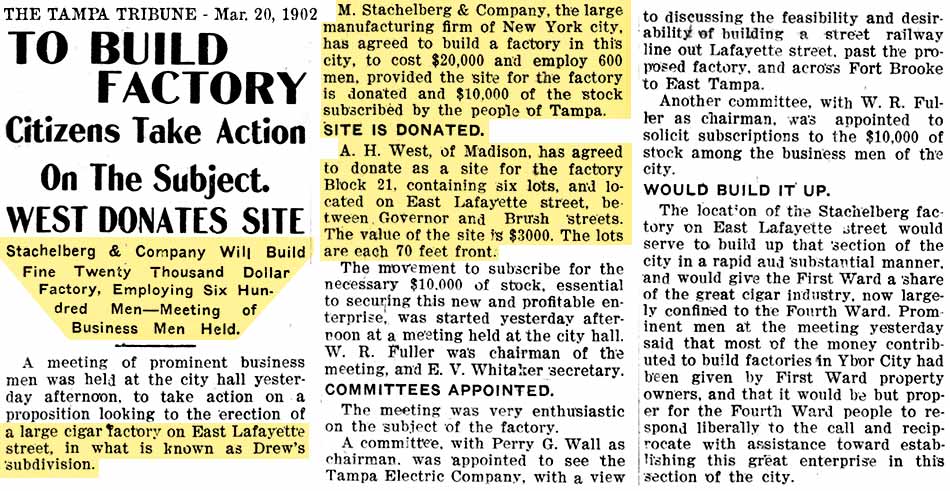
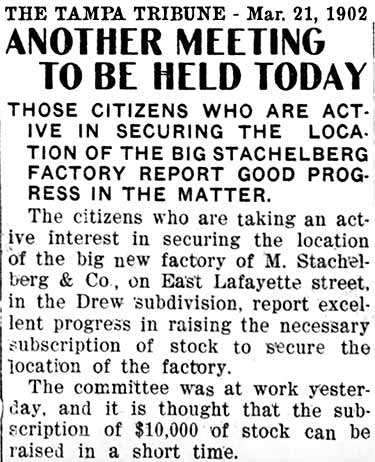 By
March of 1902 E. J. Stachelberg had already established a
factory in West Tampa that was cranking out 5 million cigars a
year. He wanted to move his entire NY operations to Tampa
so he was in the hunt for another location. Another
meeting was held on March 20th to discuss the sale of the stock. By
March of 1902 E. J. Stachelberg had already established a
factory in West Tampa that was cranking out 5 million cigars a
year. He wanted to move his entire NY operations to Tampa
so he was in the hunt for another location. Another
meeting was held on March 20th to discuss the sale of the stock.
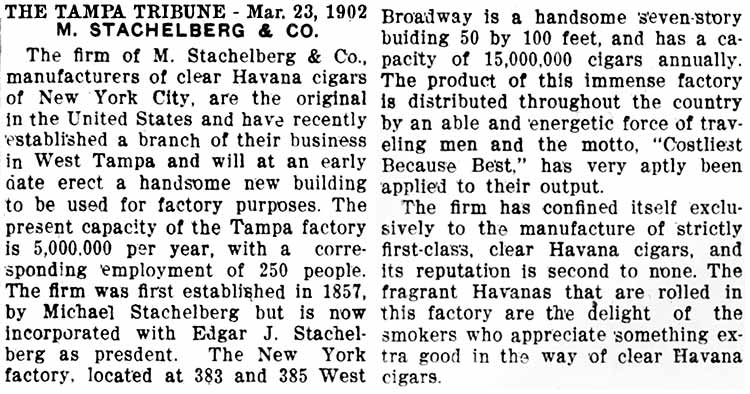
The company was founded in New
York City in 1857 by Michael Stachelberg and by 1902 Edgar J.
Stachelberg was the president. The NY factory was seven
stories tall and made 15 million cigars annually. Their
motto was, "Costliest Because Best."
Efforts to locate the Stachelberg factory location in West Tampa
on a 1903 Sanborn map and newspaper articles have been
unsuccessful.
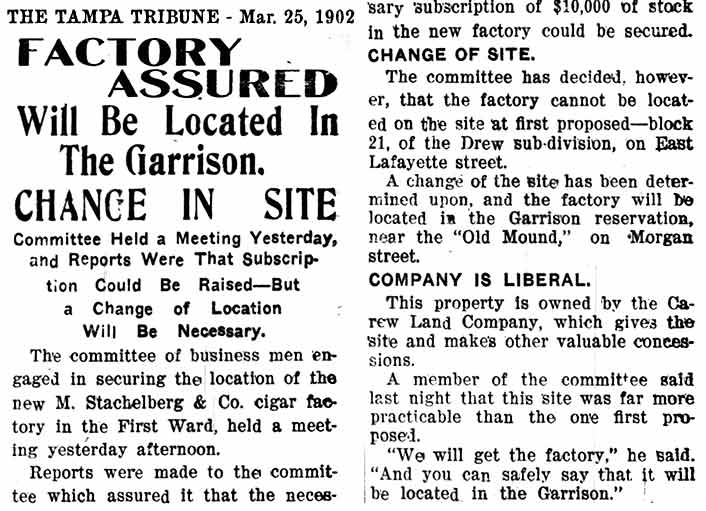
CHANGE OF PROPOSED
STACHELBERG FACTORY SITE
On Mar. 25 the
Tribune reported that Stachelberg had decided not to build in the
Drew subdivision on E. Lafayette St. and to build instead in the
"Garrison" near the "Old Mound" on south Morgan St. The
Garrison was what the old Fort Brooke land was referred to in these
days. It was a separate municipality from Tampa, and consisted
of the lands south of Whiting St. The "Old Mound" was a
referenced to the Indian mound in the southeast portion of the
Garrison. "We will get the factory, and you can safely say
that it will be located in the Garrison" was what one of the
committee members told the Tribune. The committee consisted of
land owners in the Garrison who were courting the Stachelberg Co to
build in their district.
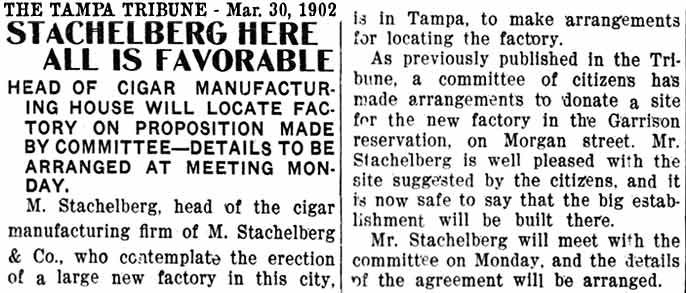
It's a pretty big deal
when you can get a leading NY cigar manufacturer who is one of the
biggest in the country to locate in your district. And why
wouldn't they, with free land as part of the deal?
FACTORY IS A SURE DEAL
On Apr. 15, 1902,
the Tribune announced that the deal was made, the contract signed,
and a general description of the building was provided: 50 ft.
x 140 ft., three stories, brick. The payroll must amount to
$200k per year and in return, the
committee would raise $13,500 toward the cost of the new building.
"The committee is now securing donations to the building fund.
Any amount over $5 would be accepted." Apparently Stachelberg
no longer required the sale of $10,000 of their stock and opted for
funds to build the factory. ($13,500 in 1908 would be like $381,858
today in 2021.)
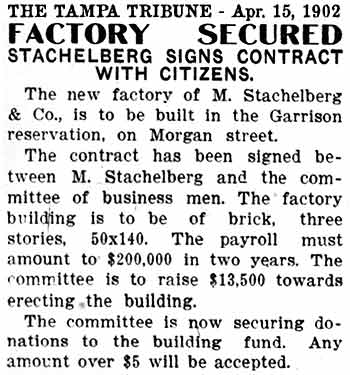 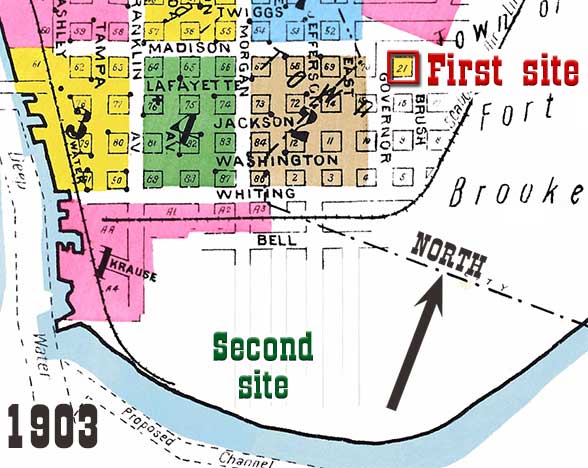
WHAT
HAPPENED TO THAT SURE DEAL?
A month and a half passed
with no more news about that definite
Stachelberg factory in the Garrison at the foot of
Morgan St. Instead, this somewhat low-key,
positive-spin article is evidence that something didn't go as planned.
Maybe the committee failed to raise the $13,500 towards
the cost of the building. It appears that the free
land wasn't enough enticement for Stachelberg. Or
maybe Stachelberg got an even better deal; an already-built,
beautiful 3-story brick building with a 4-story tower
and clock?

STACHELBERG ALREADY HAS HIS FACTORY
Edgar Stachelberg was
headed back to Tampa from NYC and will oversee "the
removal of the firm's business [from New York]...into new quarters in
the commodious
and finely appointed factory building which he recently
purchased..."
WHERE
WAS THIS FACTORY? |
.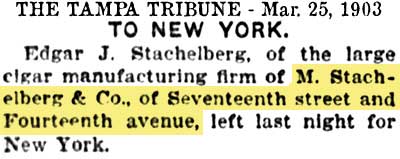 
By
spring of 1903,
their factory at 17th Street and 14th Avenue in
Ybor City was running full force.
|
WHAT
COMPANY PREVIOUSLY OCCUPIED THE YBOR CITY STACHELBERG FACTORY AND
WHEN WAS IT BUILT?
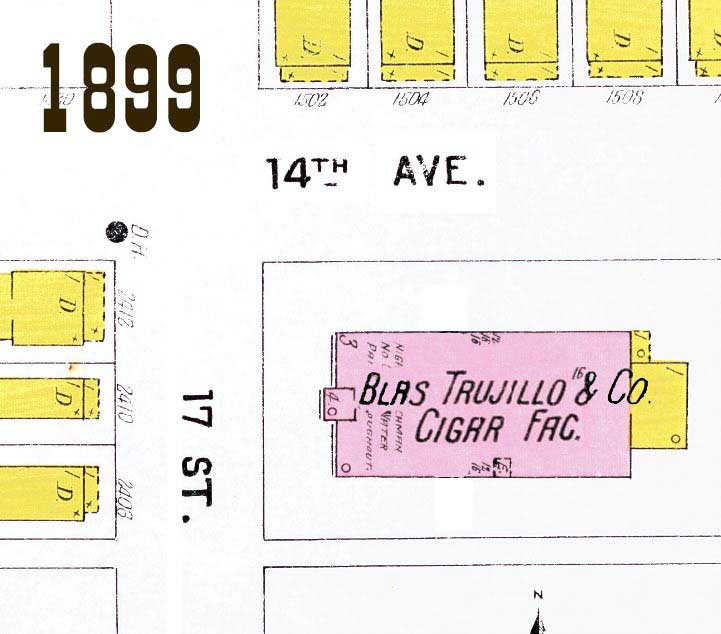
The 1899 Sanborn map of
Ybor City shows the factory was previously occupied by
BLAS TRUJILLO
& CO. Here is seen the same 3-story brick factory
with a 4-story tower centered on the front entrance.
It appears that at
some time between April 15, 1902 and March 25, 1903,
Trujillo's factory was sold to Stachelberg.
(Unless there was intermediate ownership. No article has
been located to verify this.)
WHY DID TRUJILLO SELL TO STACHELBERG?
Perhaps this event in Aug. of 1900 had something to do
with the transfer. notice the mention of "the
great clock." But was this the former courthouse
clock?
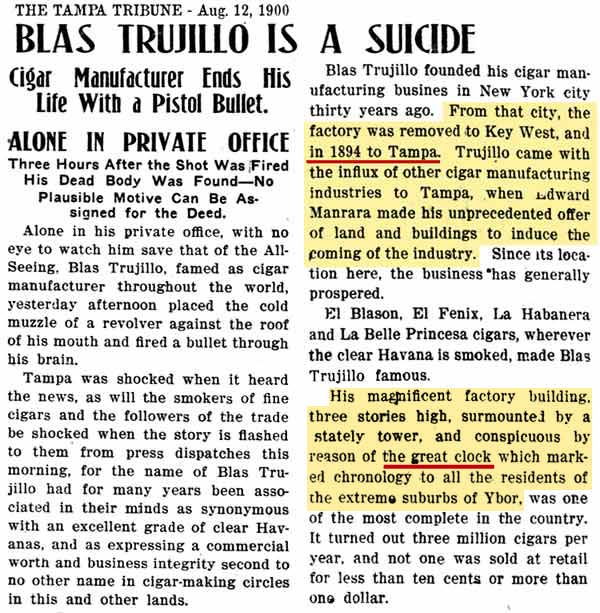
AT LEFT: All of
Tampa was shocked upon hearing of the suicide of Blas
Trujillo. This article paints a rosy picture of
his personal and business life, but a follow-up article
would reveal what was really going on.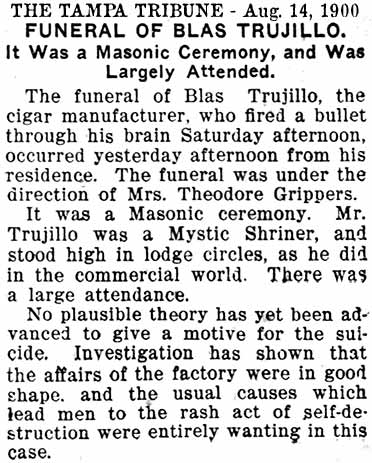
This article has been
edited to show only the beginning and the history of the
company and building in Tampa. There was
detail of the events of that day.
Click the article above to read it in its entirety.
CAUTION: It is graphic.
Newspapers of this era were quite blunt and did not try
to soften the impact of events such as this. When it
opens, click it again to see it full size.
Two days later, Blas
Trujillo's funeral took place and still the Tribune
believed that the "affairs of the factory were in good
shape, and the usual causes which lead men to the rash
act of self-destruction were entirely wanting in this
case."
Nine days after
Trujillo's funeral, the Tribune reported that public
gossip was rife with rumors about Trujillo's motive.
Things were not as rosy as first thought. Within
two weeks of each other, Trujillo's top clients went
into bankruptcy, with losses from these bad accounts
totaling $75,000. Three weeks before his suicide,
one of Trujillo's top salesmen committed suicide the
same way. It was said he felt personally
responsible for the many bad accounts he had contracted
with, and this too weighed heavily on Trujillo's mind.
Also, business had actually been slow for quite some
time; the number of employees on the payroll had been
constantly decreasing and at the time of Trujillo's
death the payroll amounted to only $500.
The big factory closed,
and those who still worked there were now idle.
The situation was in limbo until the NY partners of the
firm arrived in Tampa. It was thought that
Francisco Garcia was expressing interest in the company,
but in the end, it was Stachelberg who moved in.
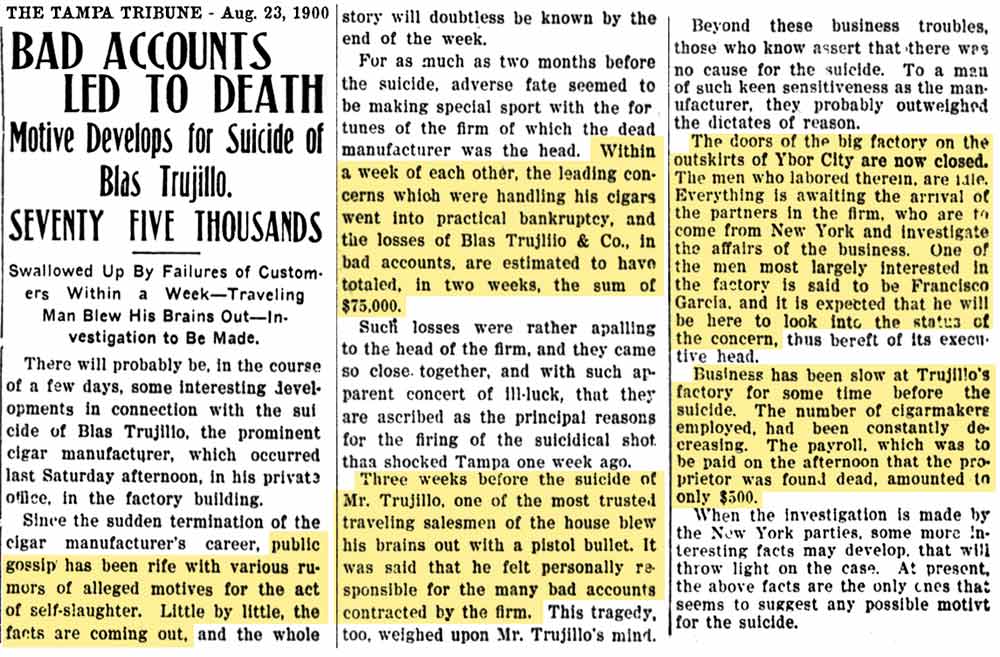
CONSTRUCTION OF THE TRUJILLO & BENEMELIS FACTORY
AND TAMPA'S FORMER TOWN CLOCK
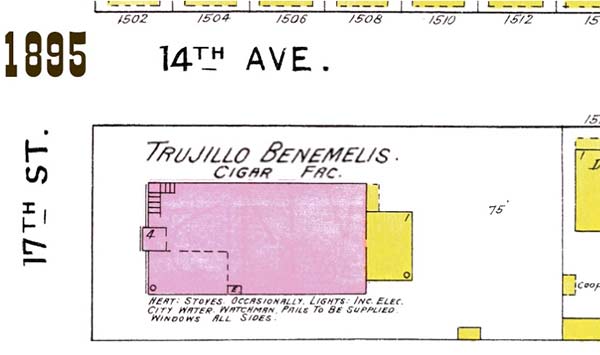 According
to the first article that reported Trujillo's death, he
came to Tampa in 1894. The 1895 Sanborn map is the
earliest to cover the area of this factory in detail.
It shows that the factory was named "Trujillo &
Benemelis." According
to the first article that reported Trujillo's death, he
came to Tampa in 1894. The 1895 Sanborn map is the
earliest to cover the area of this factory in detail.
It shows that the factory was named "Trujillo &
Benemelis."
ARTICLE BELOW:
On Jun 6, 1895, the Tribune published an article on the
success of the Trujillo & Benemelis factory. It gave a brief history
of the owners before coming to Tampa; both men were born
in Cuba. In 1892 they formed a partnership in New
York. In 1894 the Ybor City Land & Improvement Co.
enticed them to come to Tampa. Their first offer
was to build a wood frame building for them, but Trujillo and Benemelis were willing to pay one-third the cost if it
was made of brick, and so it was built of brick.
REFERENCE TO THE "OLD TOWN CLOCK"
The building was completed in Feb. 1894 at a cost of
$15,000 (or $1.5000 as the Tribune put it.) "It
occupies an enviable position on summit of a level tract
of land in the northeastern portion of Ybor City, and in
its tower the old town
clock which kept time for this city many years
is placed to keep time.."
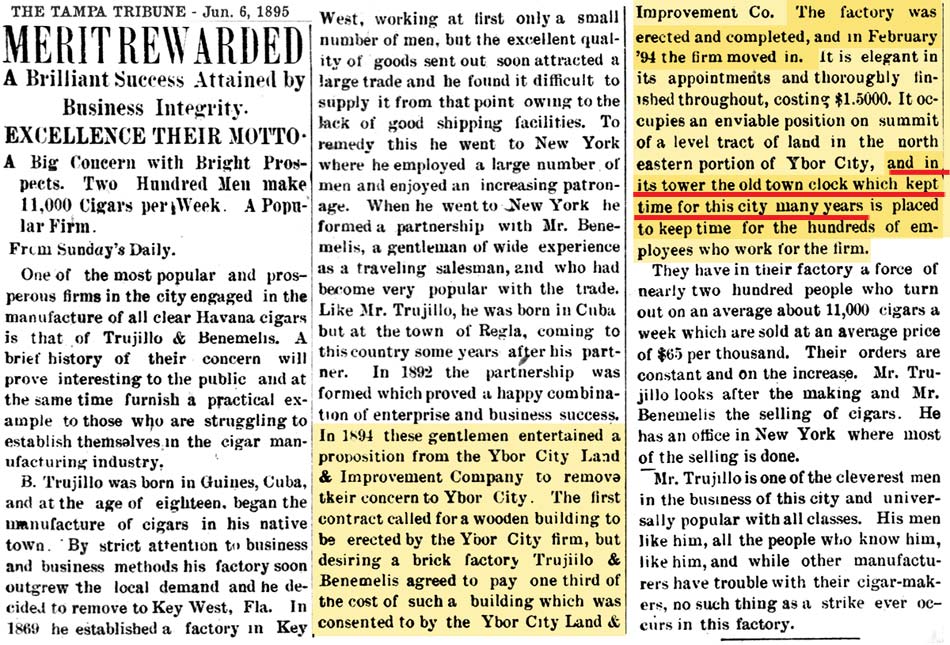
|
| |
|
WHERE
WAS TAMPA'S TOWN CLOCK BEFORE IT WAS INSTALLED IN THE
B&T CIGAR FACTORY IN 1894?
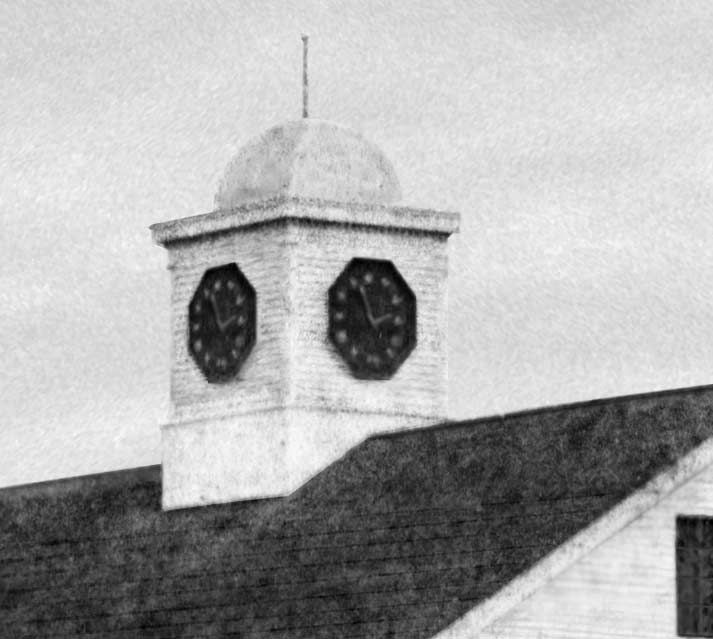 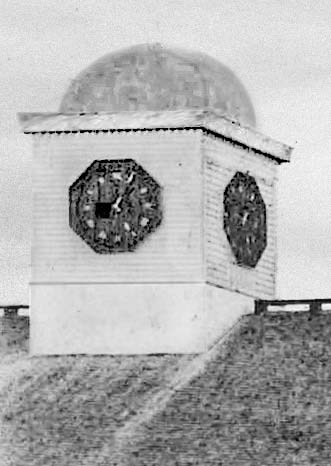 The
only clock prior to 1915 that was ever referred to as
the "town clock" was the one on the old county
courthouse built by John Breaker.
That structure was built in 1854, but a detailed
description of the new building did not mention a
clock, which suggests it was not built with a clock. The
only clock prior to 1915 that was ever referred to as
the "town clock" was the one on the old county
courthouse built by John Breaker.
That structure was built in 1854, but a detailed
description of the new building did not mention a
clock, which suggests it was not built with a clock.
|
THE TAMPA HERALD
- WED., JUNE 7, 1854.
Through the kindness of Mr. [John H.] Breaker,
contractor and builder of this magnificent Court House,
we are enabled to furnish our readers with a full
description of its order, size, various offices, etc.
etc. The building is 76 ft. long, by 45 wide, and two
stories high. ...A projecting Portico, an each end, the
whole width of the building supported by heavy Grecian
Columns. A double flight of stairs ascends from each end
of the building, landing on the 2nd floor of the
porticos. |
|
The roof is mounted with a dome and tower,
18 ft in diameter, and 24 ft high, covered with tin, or
zinc. The extreme height of the building, from the
pinnacle of the tower to the ground is 68 feet; and the
whole is being beautifully finished in a combination of
the Grecian, Ionic, and Corinthian orders..."
|
More
about Tampa's 1854 & 1891 courthouses
Also here for
the 1891 courthouse
|
FOUR-FACED CLOCK ADDED
IN 1882
|
|
|
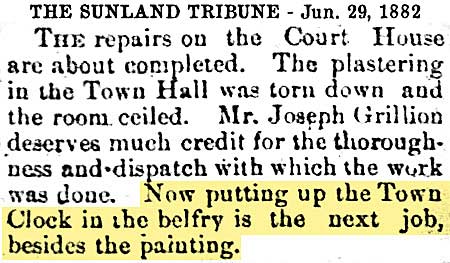 |
In June of 1882 the old Breaker Courthouse
underwent some much needed repairs which included
tearing down the old plaster and installing a ceiling in
the Town Hall meeting room. This Jun. 29, 1882
article says "Now putting up the Town Clock in the
belfry is the next job, besides the painting."
|
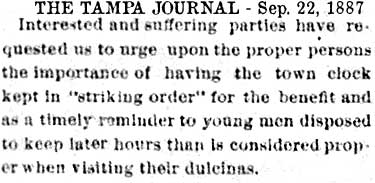
In Sep. 1887 the town
clock striking
mechanism was out of order. |
WHERE WAS
THE TOWN CLOCK PURCHASED FROM?
In 1881 dentist and
jeweler E. Neve ended his partnership with Dr. H. P.
Jensen and sold his entire interest in the drug business
to S. B. Leonardy. Neve continued as a jeweler and
dentist.
|
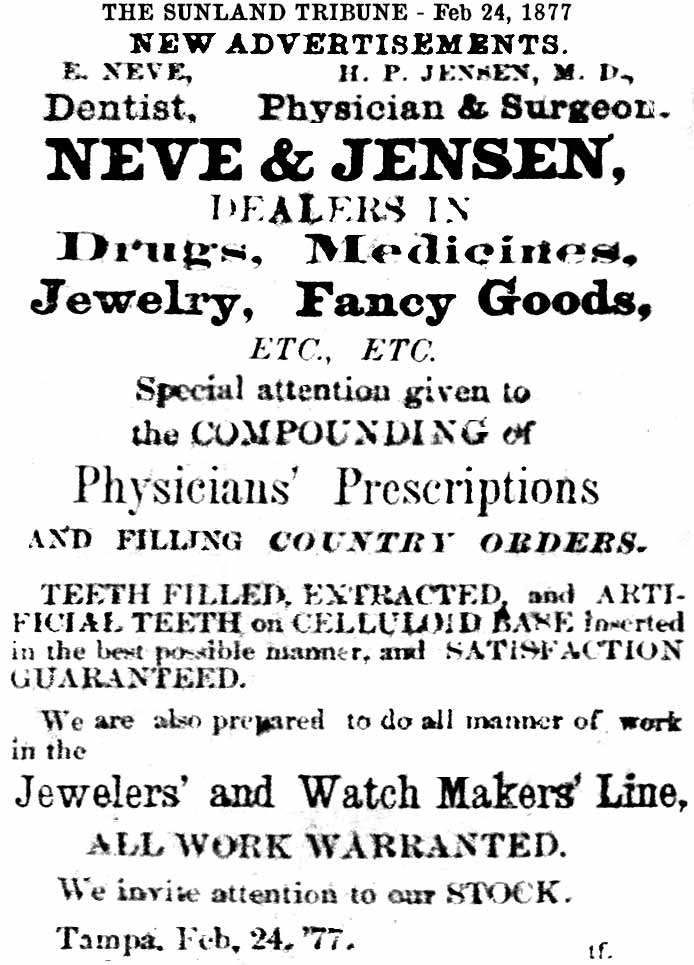
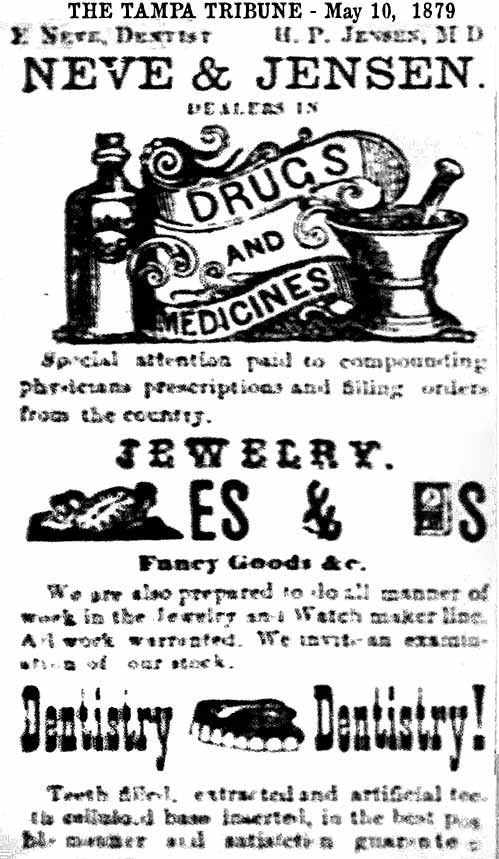
Neve
continued his jewelry business in Leonardy's drugstore. |
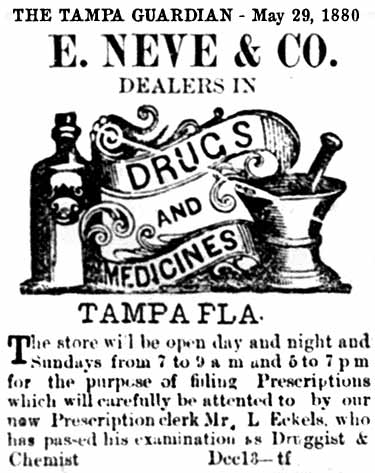
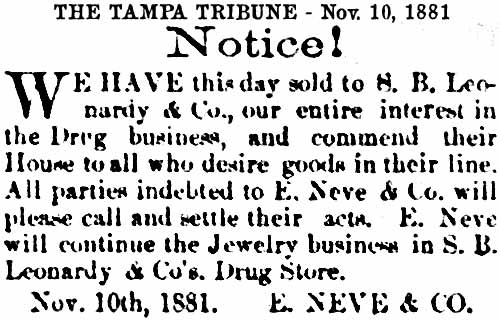 |
CLOCK ORDERED
In January
1882 E. Neve ordered the town clock from Seth Thomas of
New York; it was built in
Thomaston, CT. On page 19 of the Seth Thomas tower
clock installations catalog for Florida can be seen that the
clock installed in the new City hall in 1915
("Hortense") was the same model as the one that had been
installed in the courthouse in 1882. The only
difference was the clock faces and dials, and probably
the bell.
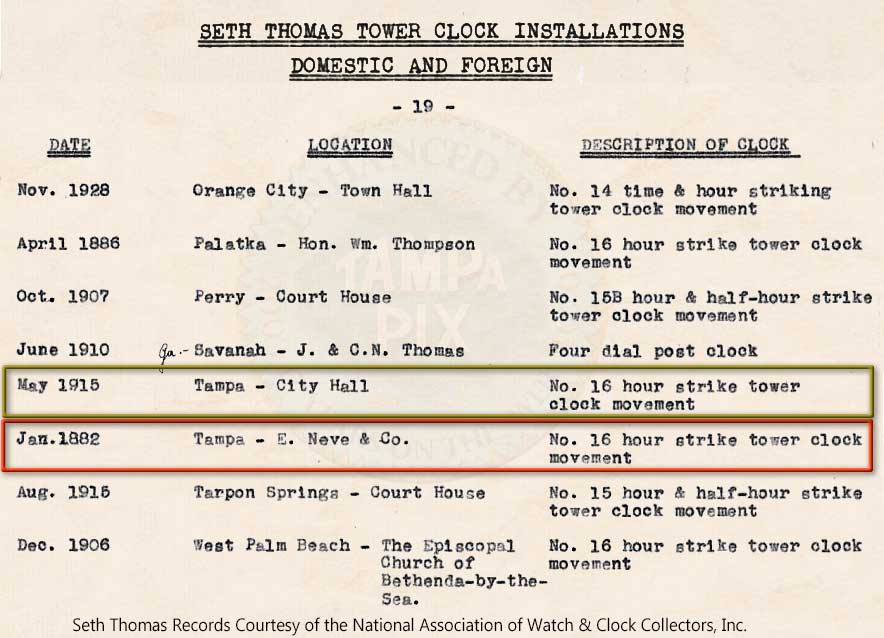
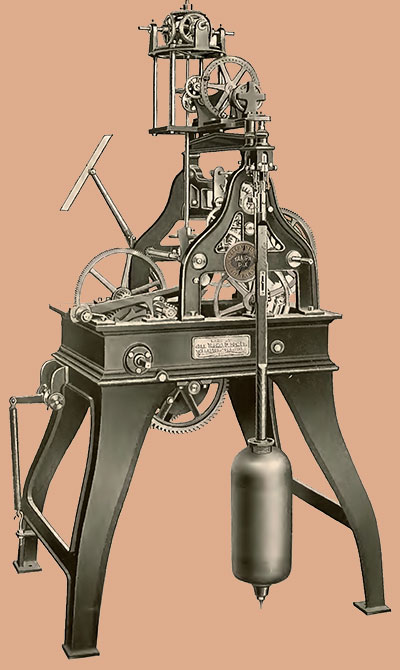
BREAKER COURTHOUSE SOLD
In
preparation for a new brick courthouse, the old courthouse was
sold to J. J. Kinsman and moved north on Fla. Ave.
across from the Palmetto Hotel in 1891. The property was
owned by Kinsman who was a blacksmith and wagon maker. His shop
and home were on the property so he first had his home
moved to another location.
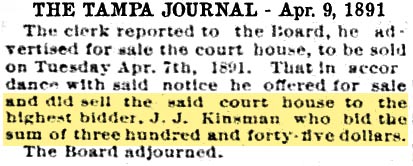
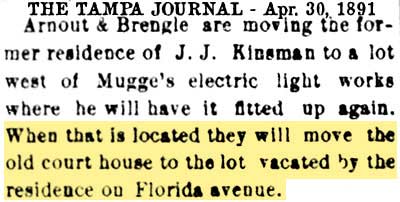
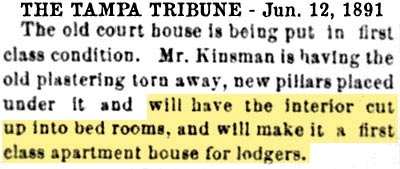
|
|
|
|
|
THE BREAKER COURTHOUSE'S SECOND LIFE
The old courthouse building was used as the Magnolia
House apartments in 1895.
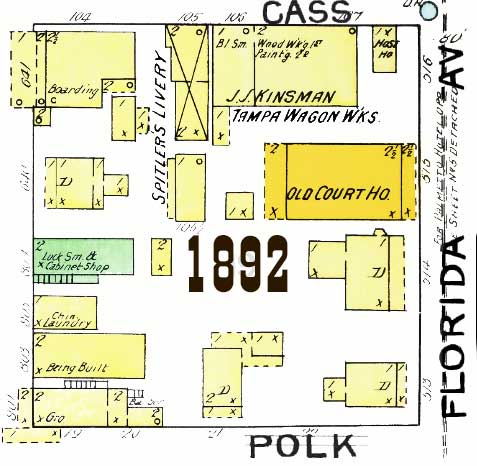 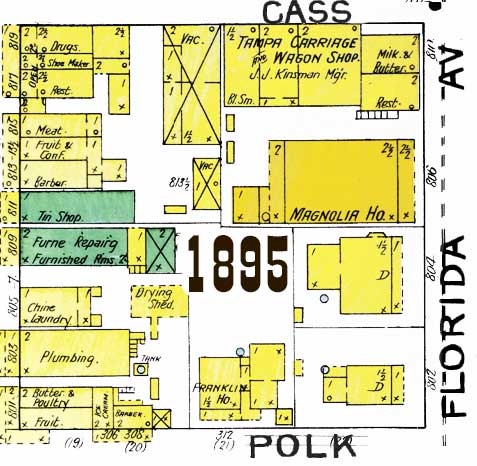
By
1899 it
became the Avenue Hotel
owned by M.J.
Morales and caught on fire on Dec. 4.
The fire started
at the
cottage next to it and spread to the roof of the hotel.
Chief A. J. Harris and five firemen worked
six hoses and doused the fire in a heroic
effort. All twenty guests escaped
unharmed but the top floor was gutted and
the first floor drenched. The article
describes
the building
as three
stories but
they are
counting the
space under
the
roof--the
attic.
The Sanborn
maps show "2
˝" stories
which is how
attic space
was
indicated. Evidently
the building was repaired because
in 1903 it appears on the Sanborn maps as the Tampa Sanitarium
(a hospital.)
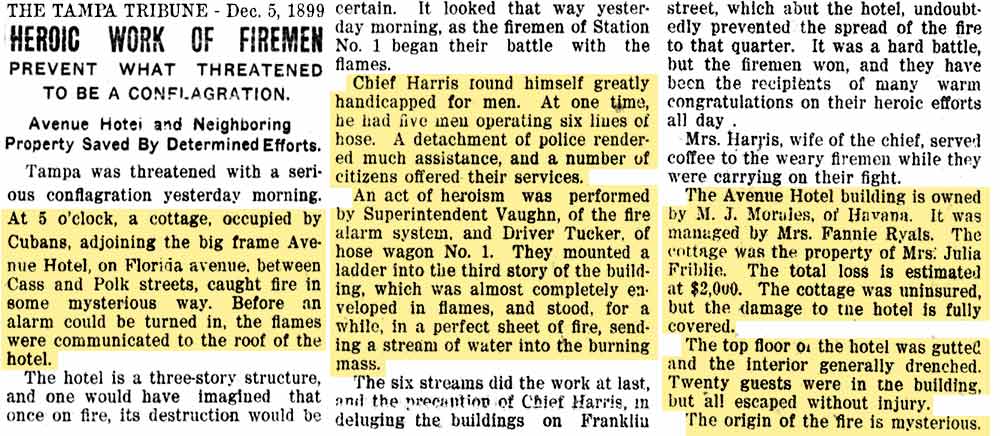 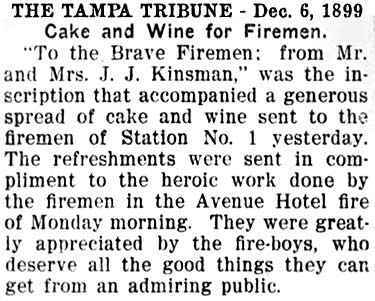
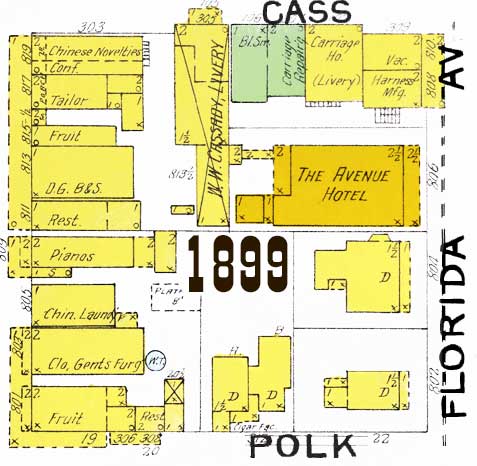 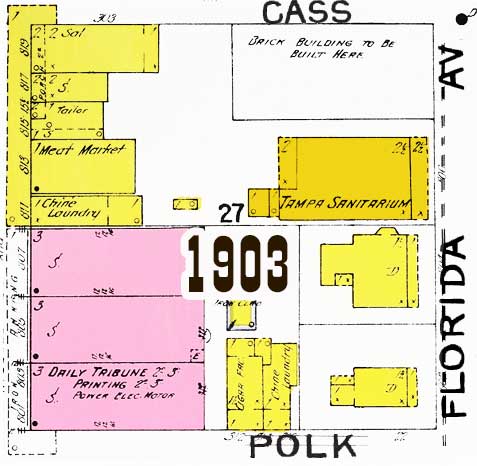
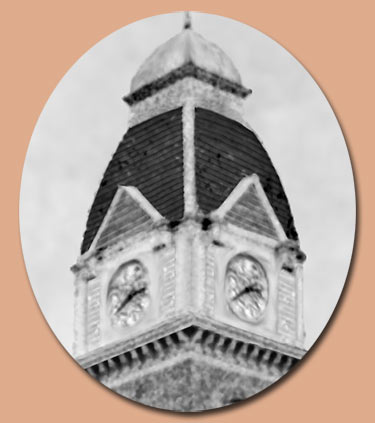
The old courthouse clock became the Trujillo & Benemelis
cigar factory
clock by 1894, and later the Stachelberg clock in the
same building. Seth
Thomas offered some options for the clock faces, and
judging from photos of the courthouse clock and the
Stachelberg clock, it appears that Trujillo & Benemelis
or Stachelberg
opted to get fancier faces for it. Ultimately, the
clock was destroyed in the great Ybor City
fire of 1908.
READ ABOUT ANOTHER CLOCK JUST LIKE THIS ONE,
ONLY MUCH MORE FAMOUS: HORTENSE! |
|
WHO WAS E. NEVE?
Edvard Dinus Neve
was born on Aug. 7, 1849 in Denmark, and was
a son of Abraham Eberhardt Neve. In August
of 1871 he left from Copenhagen and
sailed to America, settling in Tampa in that
same year.
Upon
arriving in Tampa, Neve engaged in the
jewelry business for a time, being an expert
watchmaker, a trade he had learned as a boy
in Denmark. However, he became
interested in dentistry and took up the
study of it, making great strides in that
field. Dr. Neve was the recipient of a
prize medal for the unusual excellence
of certain operations he performed at a
convention of dentists of national
reputation.
|
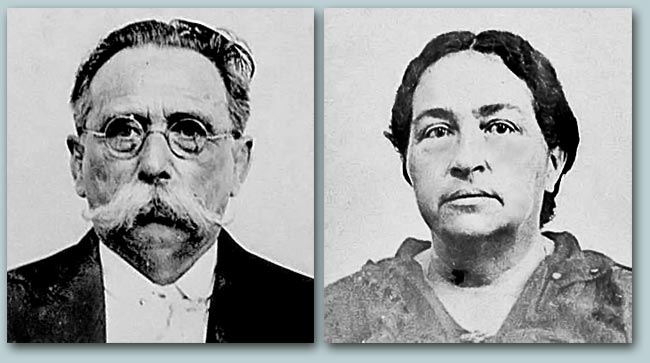
Dr. Edward D. Neve and wife Alicia M.
Gonzalez Neve
1920 Passport application photos.
|
|
It was by this
work he was best known in Tampa, and while
he was engaged in it he enjoyed a very large
and lucrative practice.
In 1895 he
married Alicia Gonzalez;** she was born on
Oct. 9, 1869 at Philadelphia, a daughter of
Havana, Cuba native Prof. Guillermo P.
Gonzalez, a public school teacher. (In
May 1895, Mrs. Neve was given the honor of
naming a new 480-acre suburb being developed
in Tampa northeast of Ybor City.
"After a search of Spanish lexicons she
selected "Campobella" meaning "beautiful
country.")
Later,
after retiring from dentistry, he invested
in citrus lands as well as city property and
owned several large groves in the area, one
of the finest being just beyond Myrtle Hill
Cemetery.
Dr. Neve
and his wife applied for passports in early
June of 1920 to travel to Denmark, Norway,
Holland, Belgium, France, Spain and England,
to leave from the Port of New York in May or
June of 1921 on a vacation for six months.
At the time, they lived in Tampa at 1103
Tampa Street.
But in
July, 1920, he and his wife decided to visit
relatives in Denmark, and while preparing to
depart from New York City, Dr. Neve had a
severe attack of appendicitis on July 11 and
died following an operation at St. Vincent's
hospital. He was about 70 years old.
Alicia died in Tampa in 1952.
**His
obituary says he and his wife left
Copenhagen in 1871, but all evidence so far
indicates he was not married at the time.
He married in 1895
according to his and Alicia's censuses and
passport applications. Also, their
1910 census indicates this was the first
marriage for both of them.
The above
is information from Edward's obituary in the
Tampa Tribune on July 17, 1920, combined
with information from a May 21, 1895 Tribune
article, his and his wife's passport
applications and 1880, 1900, 1910 and 1920
censuses.
|
|
"MEET THE FRECKERS" Prelude to a New City Hall
Close this window to return to previous page.
|
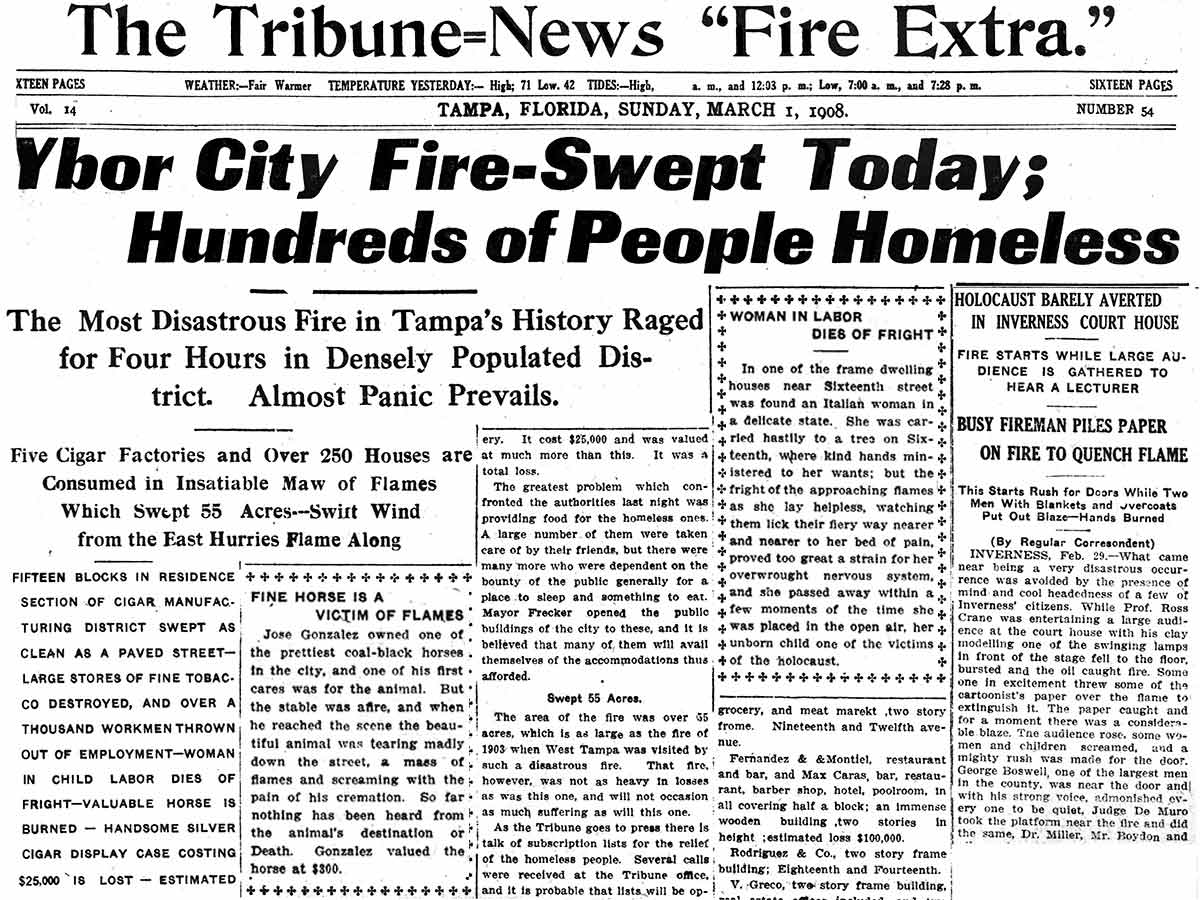







 There
are plenty of mentions of the Stachelberg cigar company and
factory in the Tampa Tribune for this period. The Tribune carried ads for their cigars.
According to his 1904 Tribune article, it was managed by former Tampa
Mayor Herman Glogowski when they moved their entire operations to
Tampa from New York, to their "present large brick factory, known as
the 'clock factory.'"
There
are plenty of mentions of the Stachelberg cigar company and
factory in the Tampa Tribune for this period. The Tribune carried ads for their cigars.
According to his 1904 Tribune article, it was managed by former Tampa
Mayor Herman Glogowski when they moved their entire operations to
Tampa from New York, to their "present large brick factory, known as
the 'clock factory.'"























































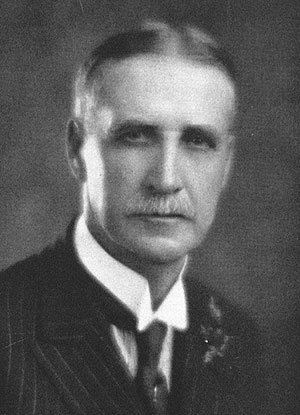



 By
March of 1902 E. J. Stachelberg had already established a
factory in West Tampa that was cranking out 5 million cigars a
year. He wanted to move his entire NY operations to Tampa
so he was in the hunt for another location. Another
meeting was held on March 20th to discuss the sale of the stock.
By
March of 1902 E. J. Stachelberg had already established a
factory in West Tampa that was cranking out 5 million cigars a
year. He wanted to move his entire NY operations to Tampa
so he was in the hunt for another location. Another
meeting was held on March 20th to discuss the sale of the stock.














 The
only clock prior to 1915 that was ever referred to as
the "town clock" was the one on the old county
courthouse built by John Breaker.
That structure was built in 1854, but a detailed
description of the new building did not mention a
clock, which suggests it was not built with a clock.
The
only clock prior to 1915 that was ever referred to as
the "town clock" was the one on the old county
courthouse built by John Breaker.
That structure was built in 1854, but a detailed
description of the new building did not mention a
clock, which suggests it was not built with a clock.


















